实例介绍
【实例简介】Principles of Computer System Design: An Introduction Part II - 826 pages
MIT 6.033 的教科书,第二部分,7-11章
【实例截图】
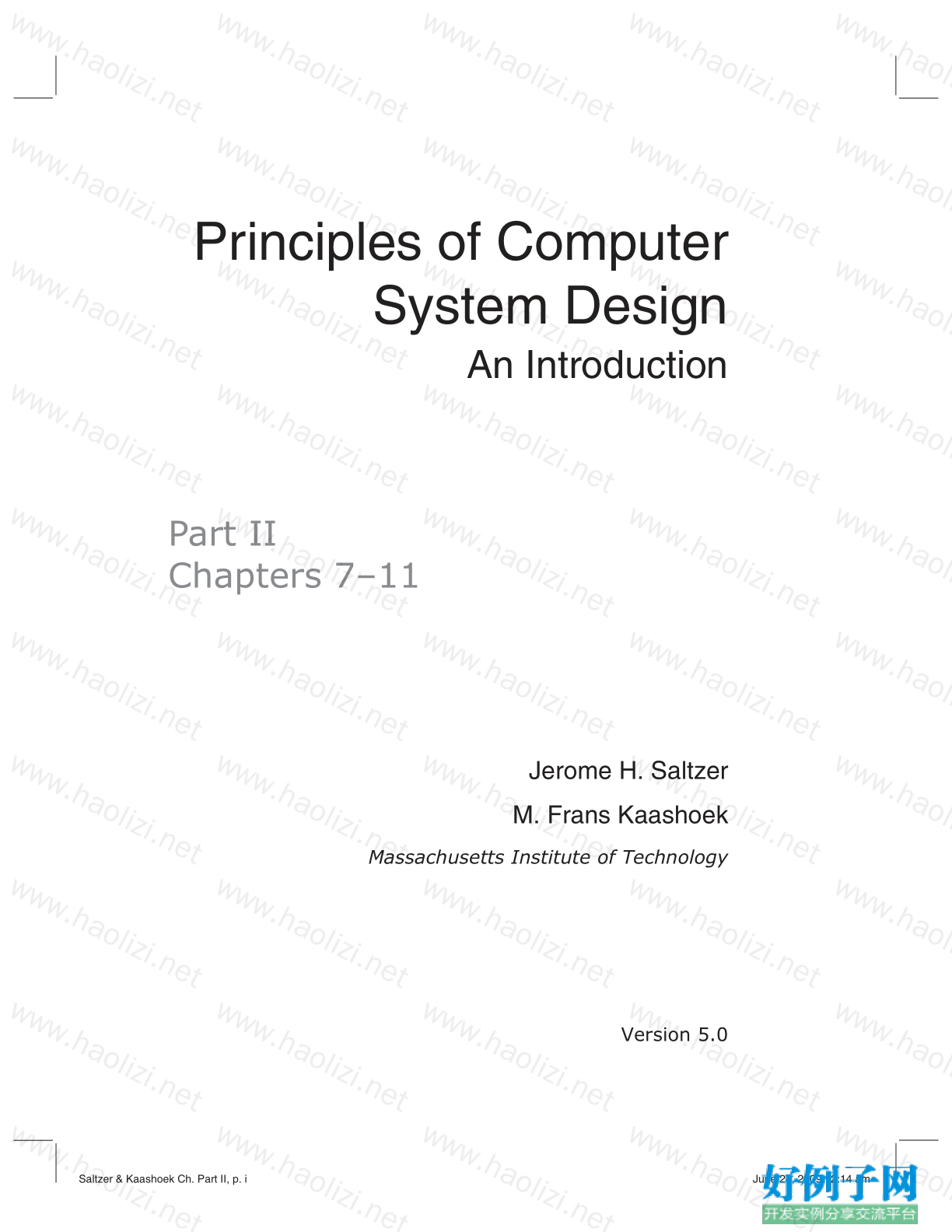

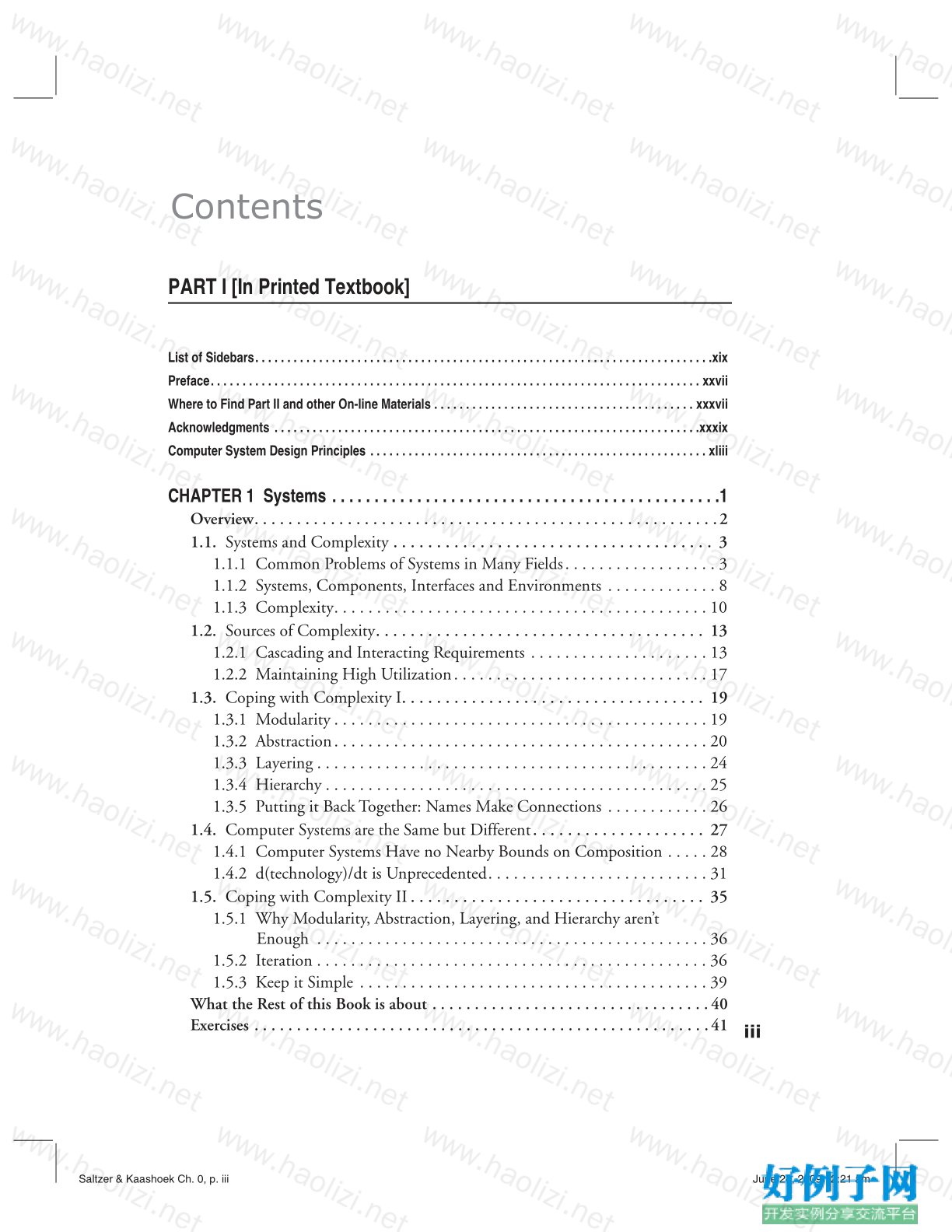

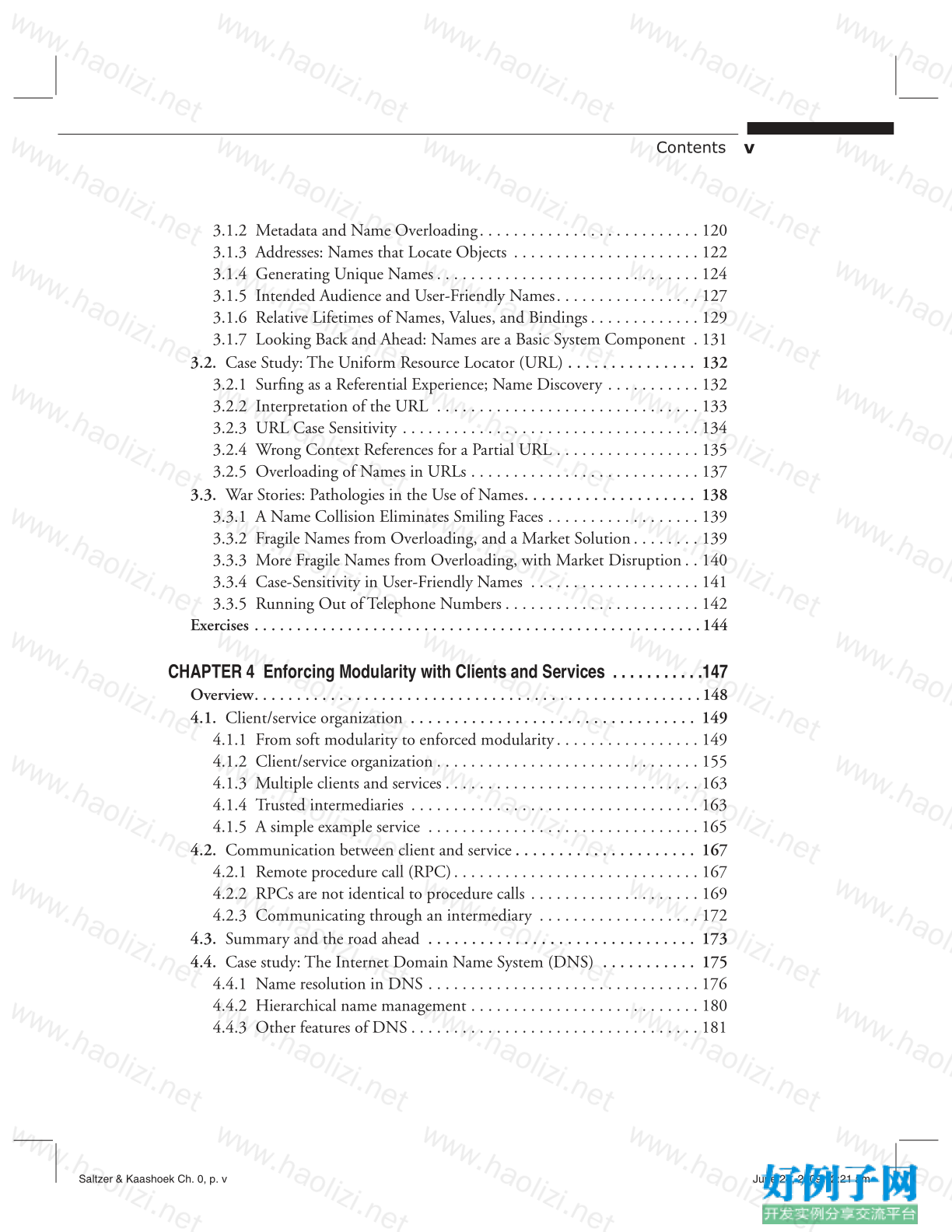
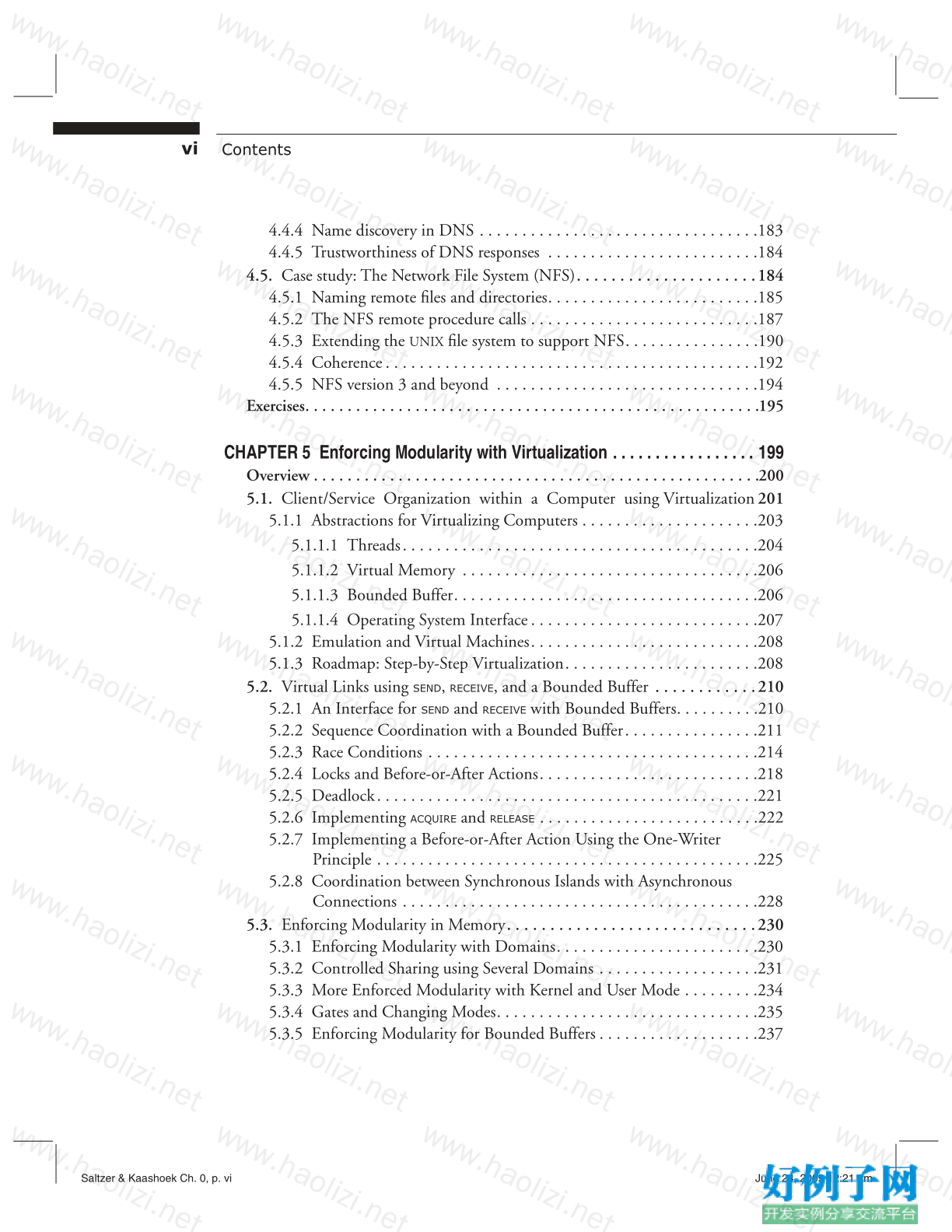



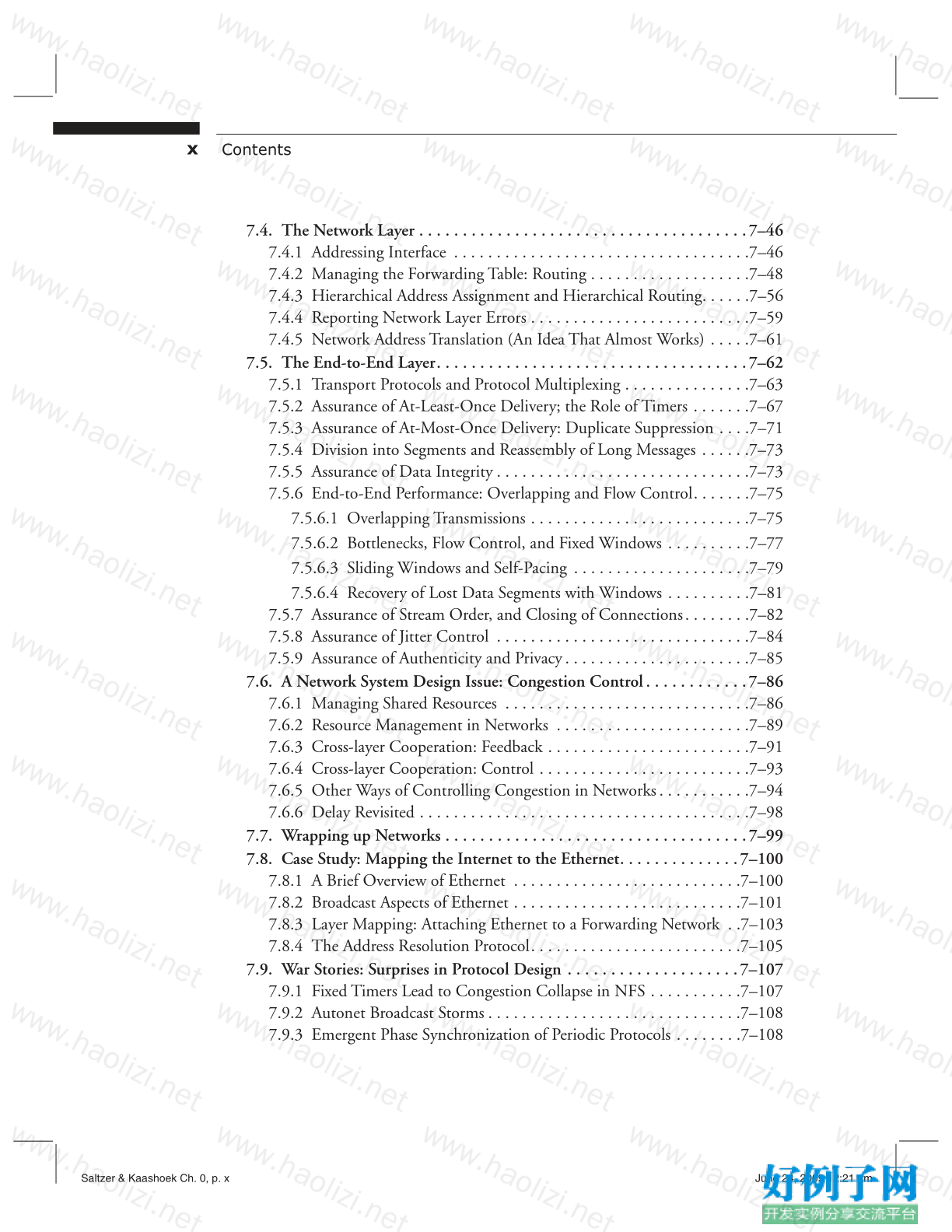

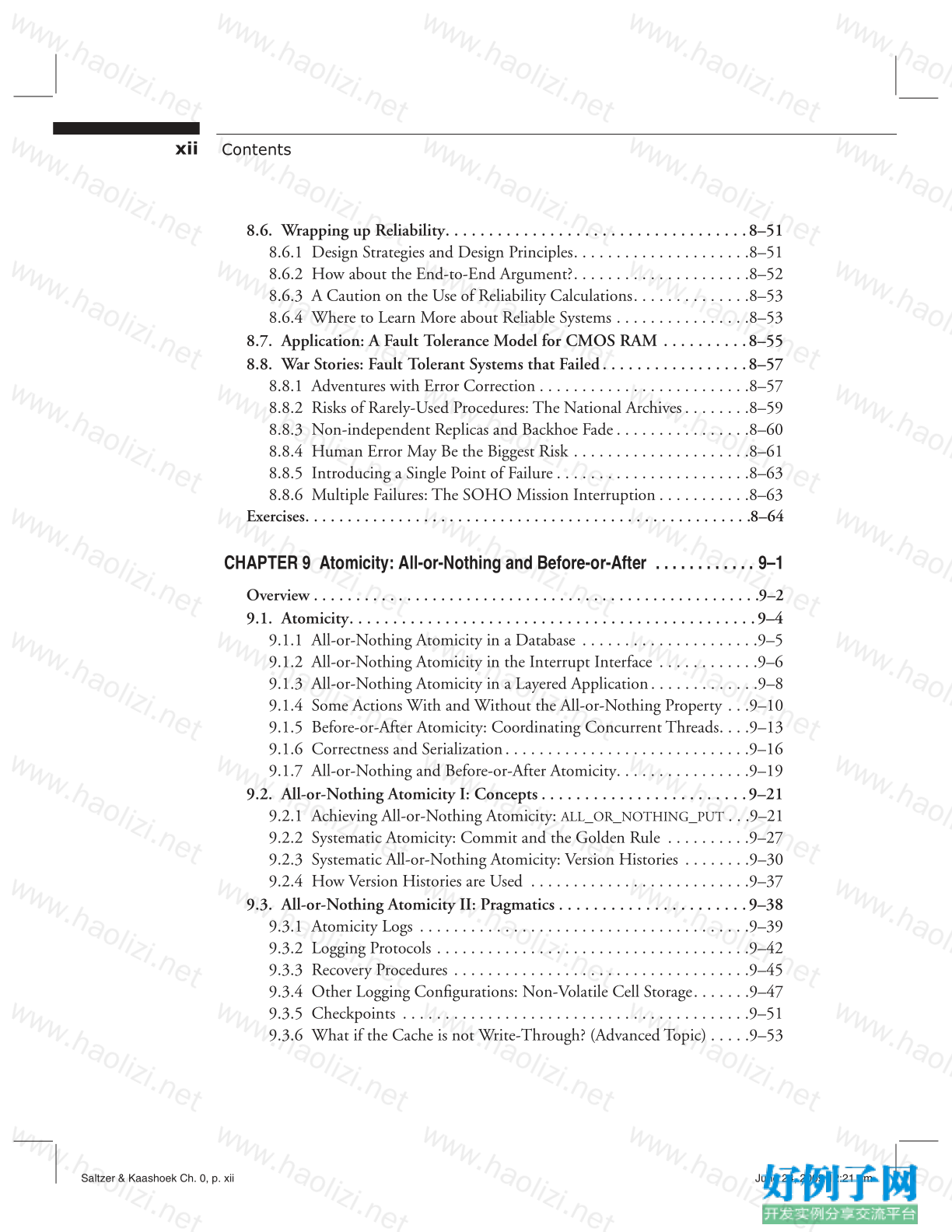
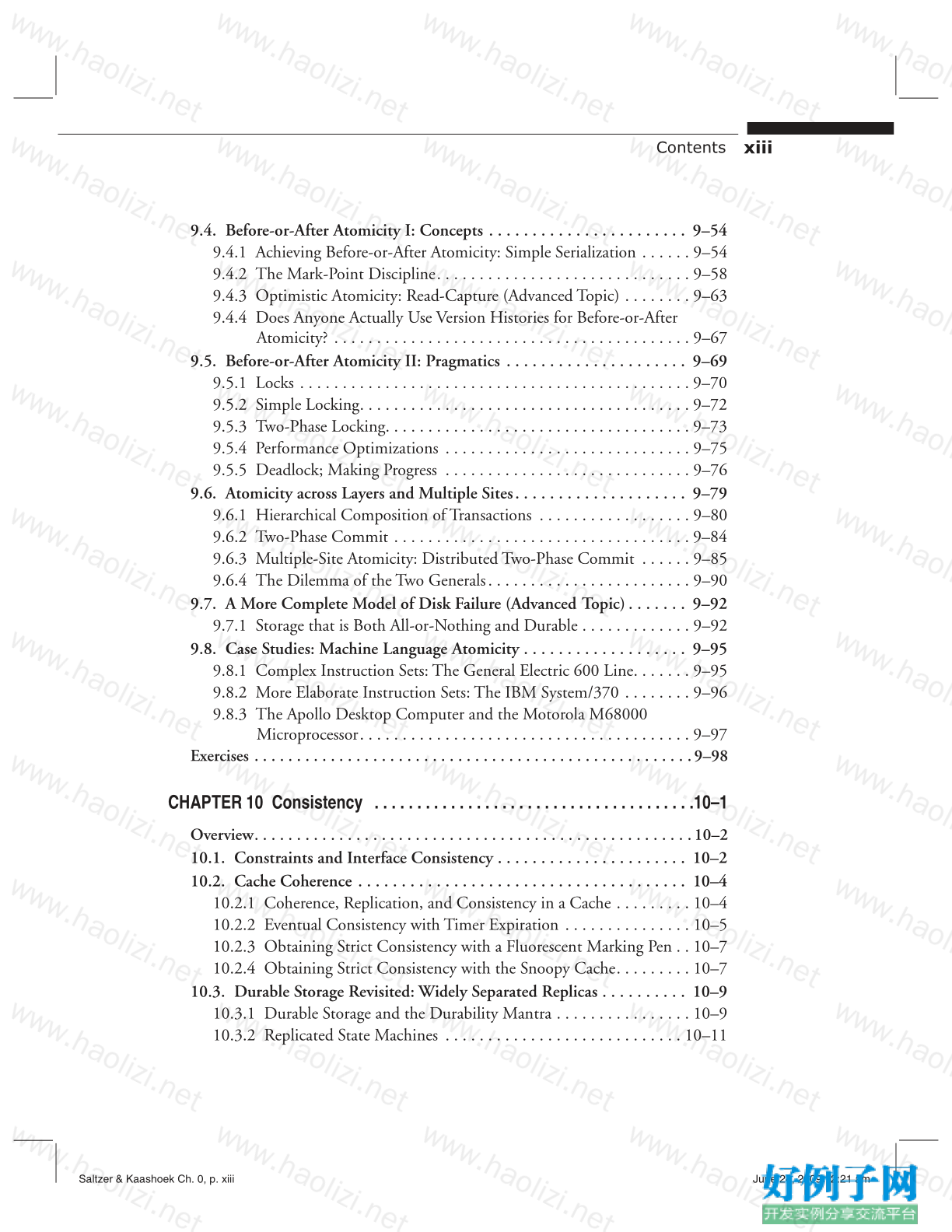

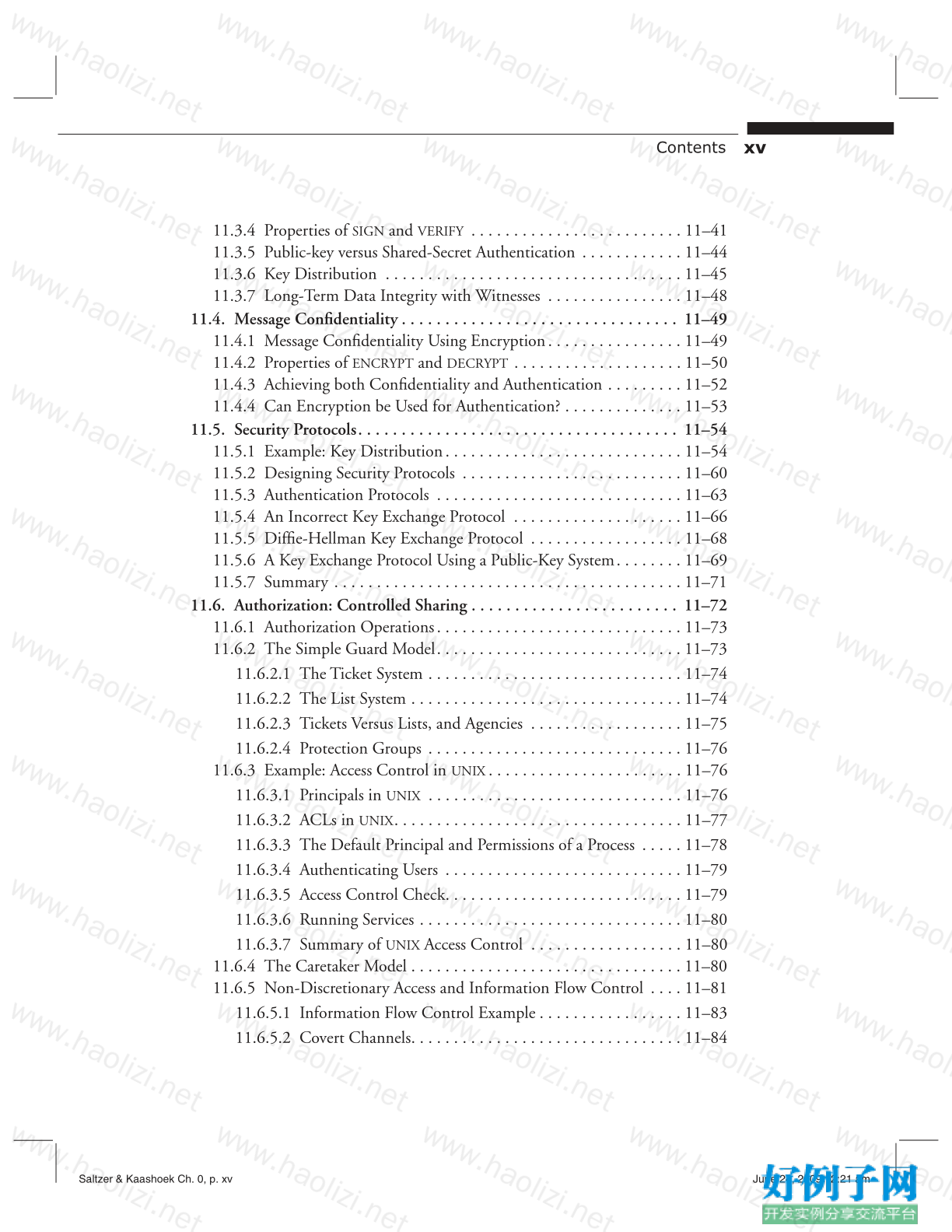
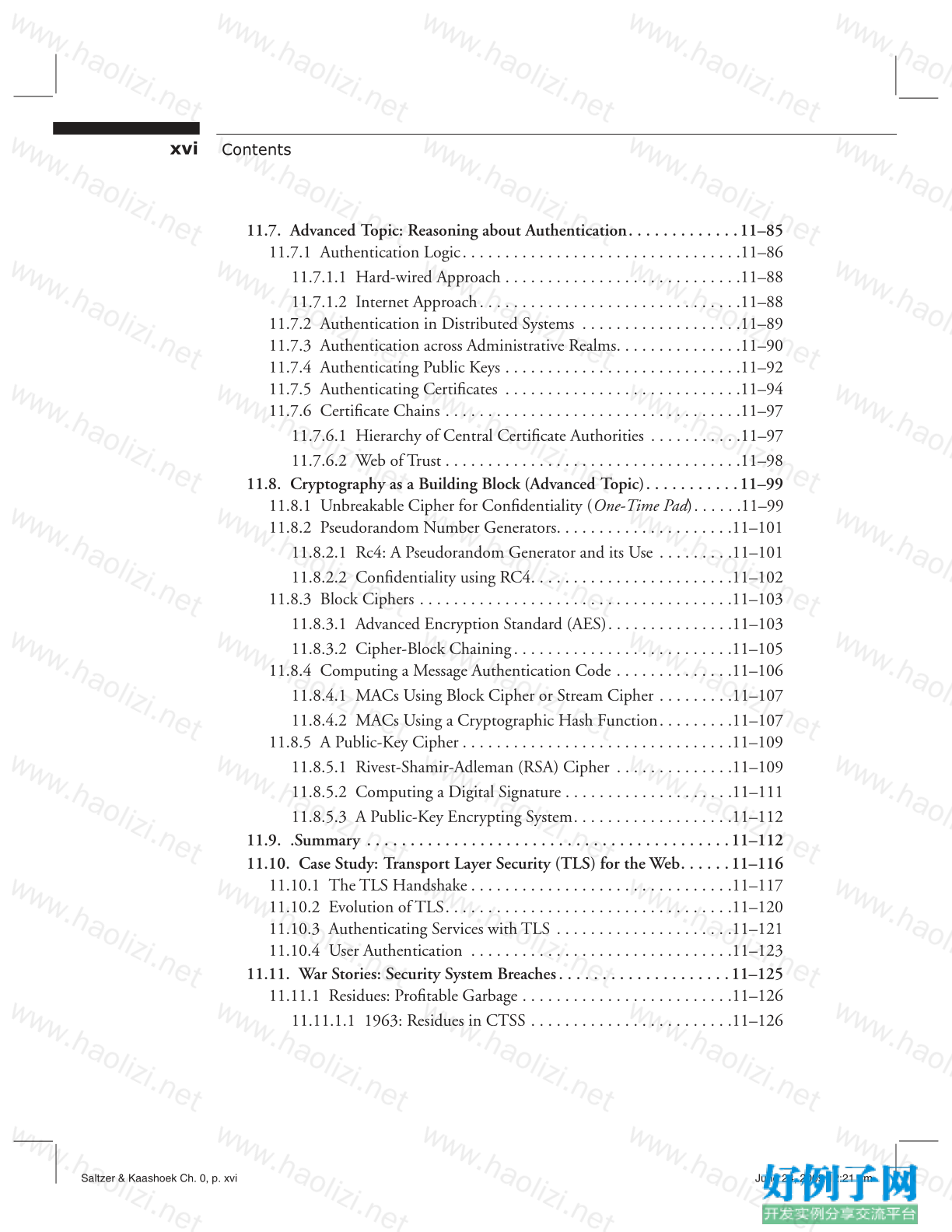


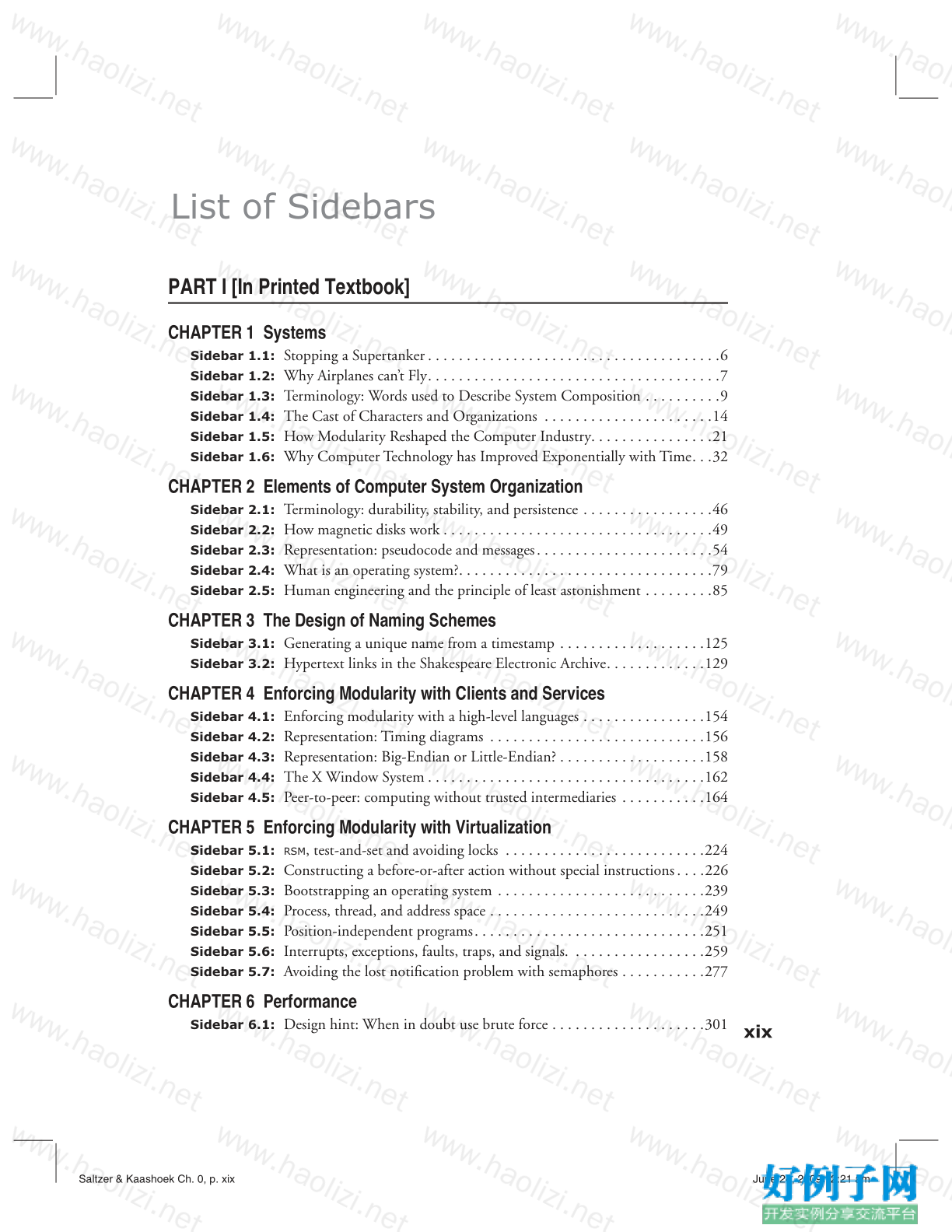

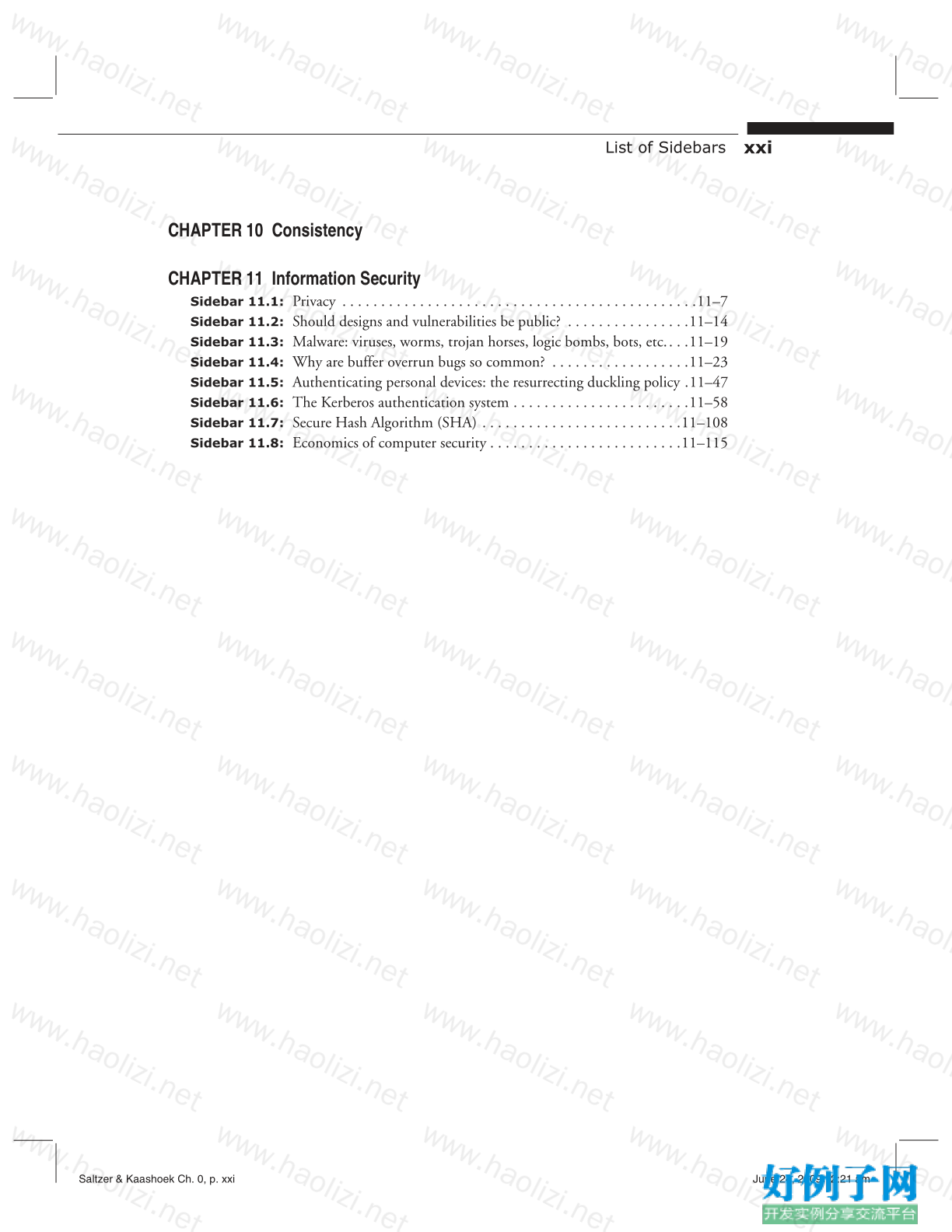
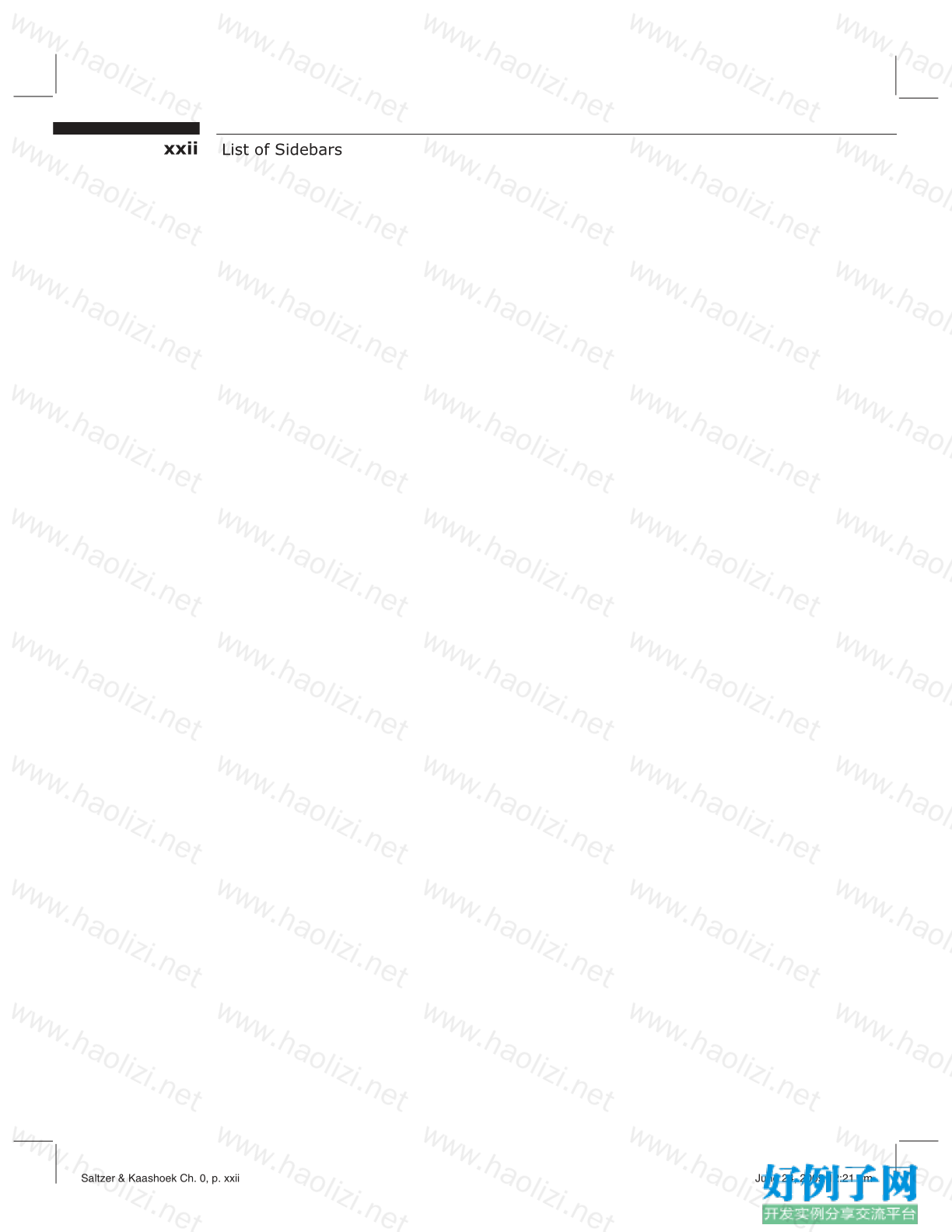

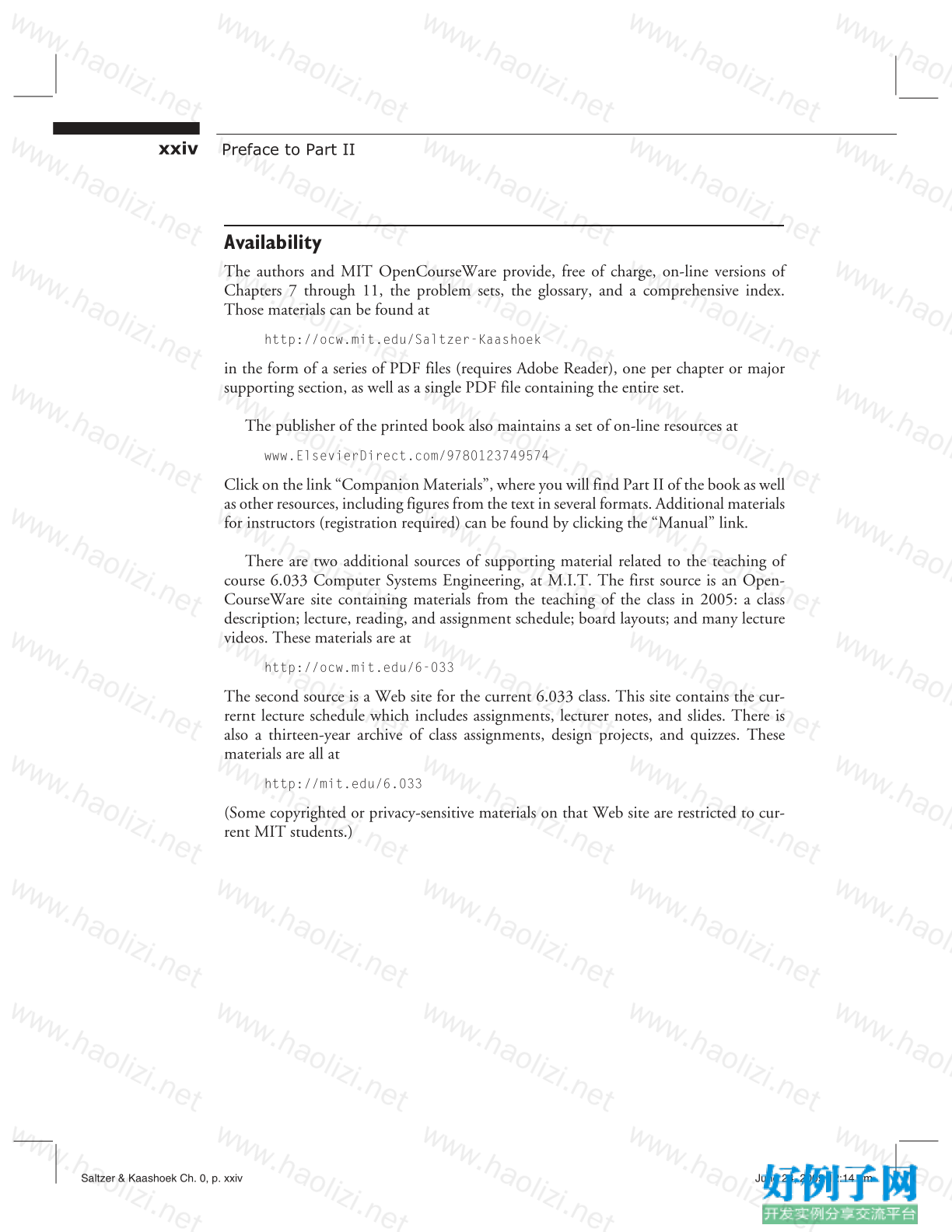
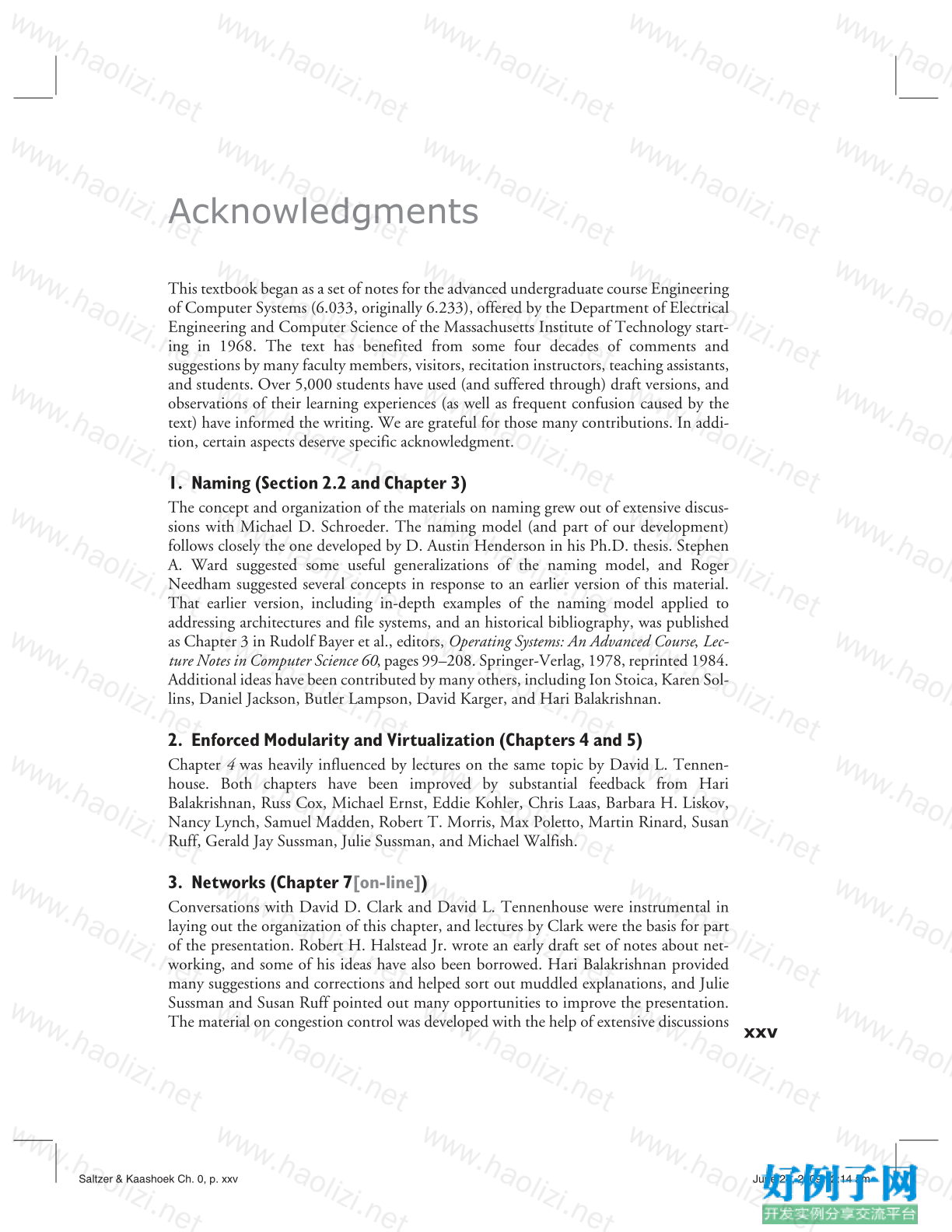

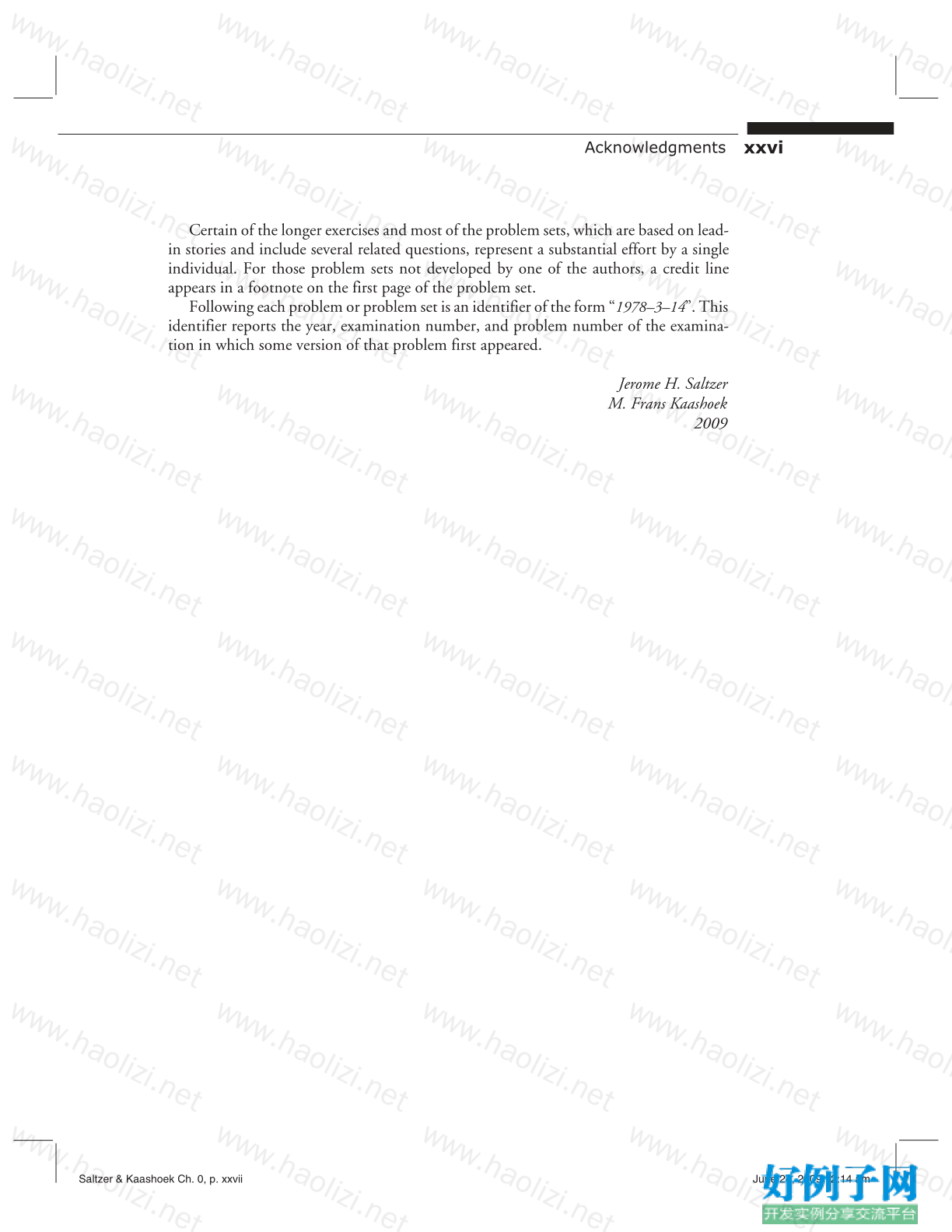
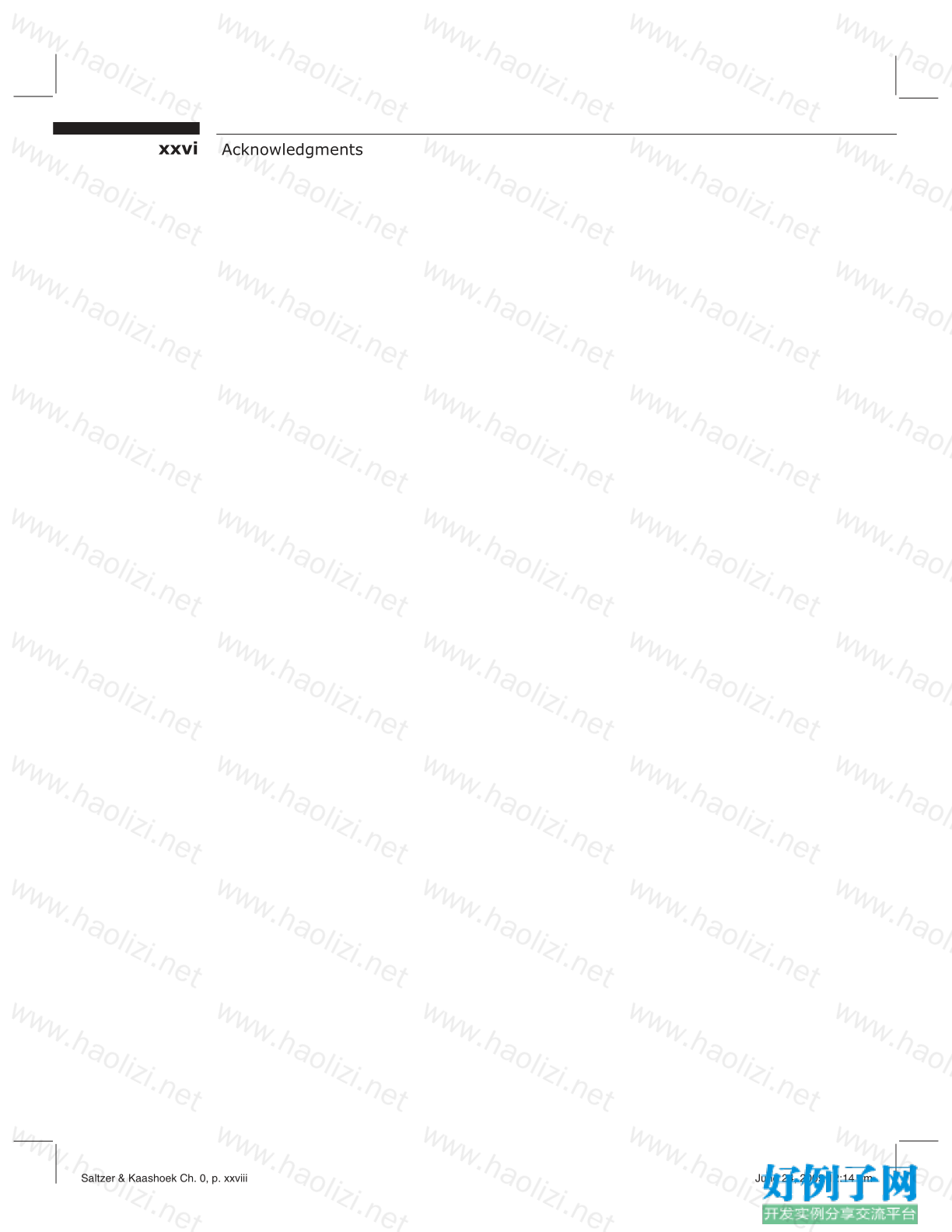

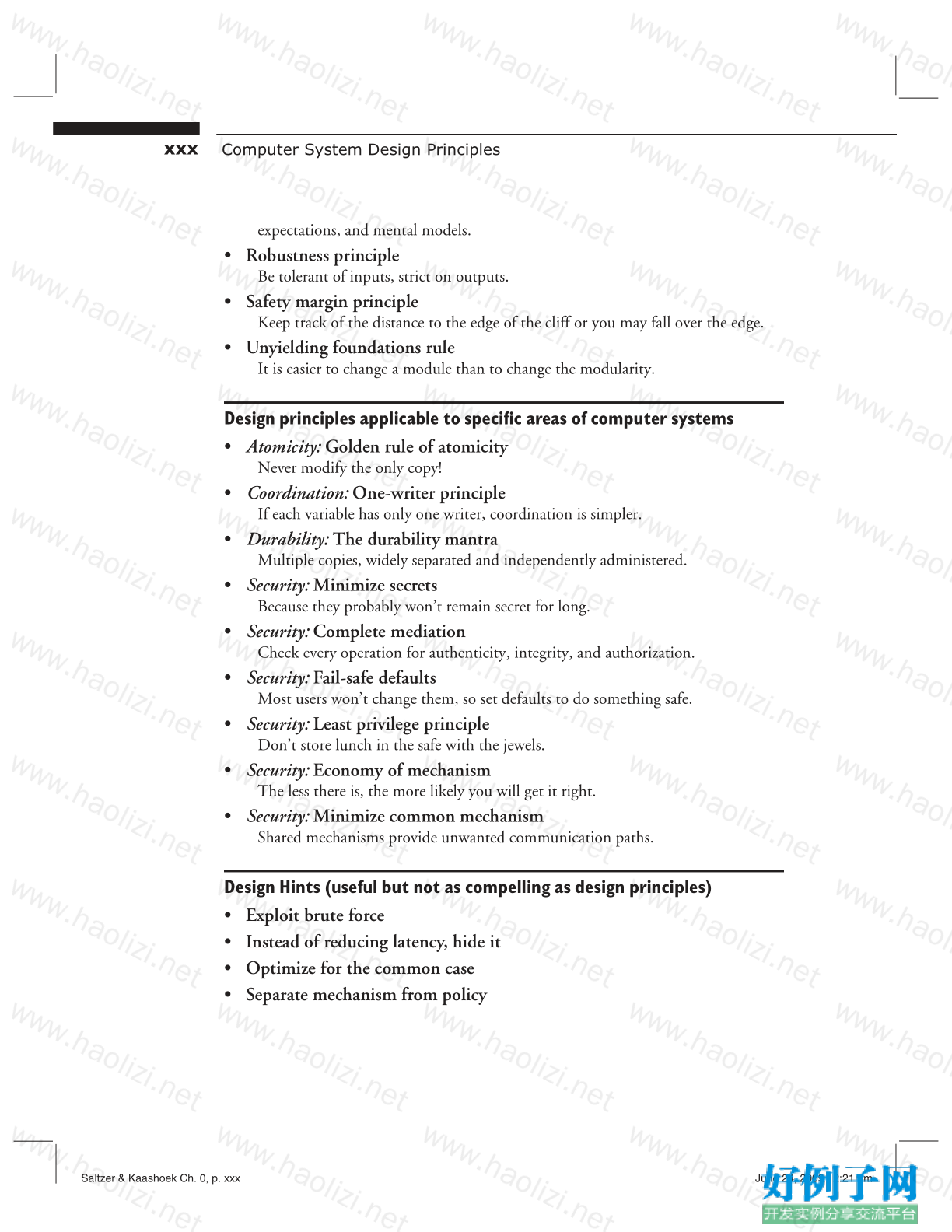
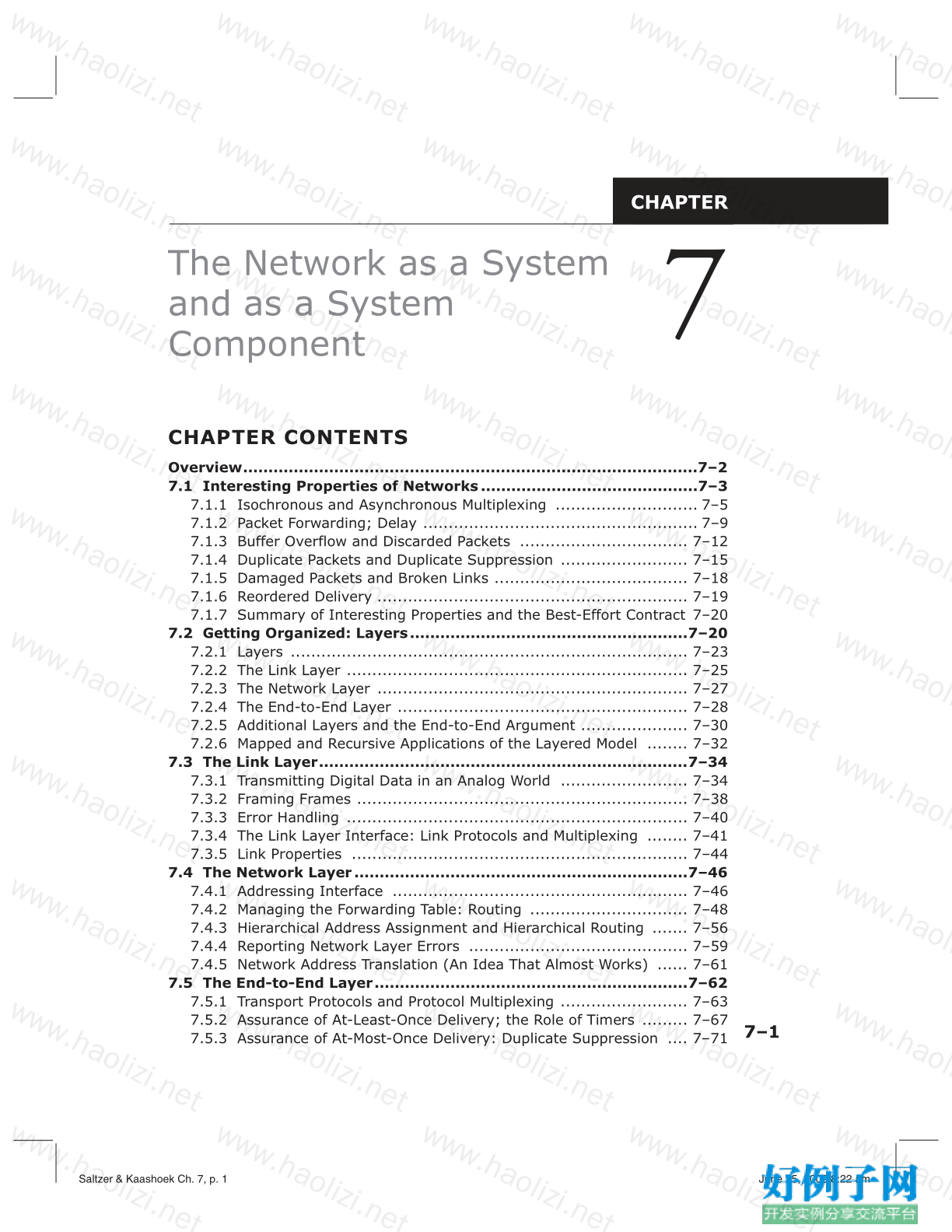
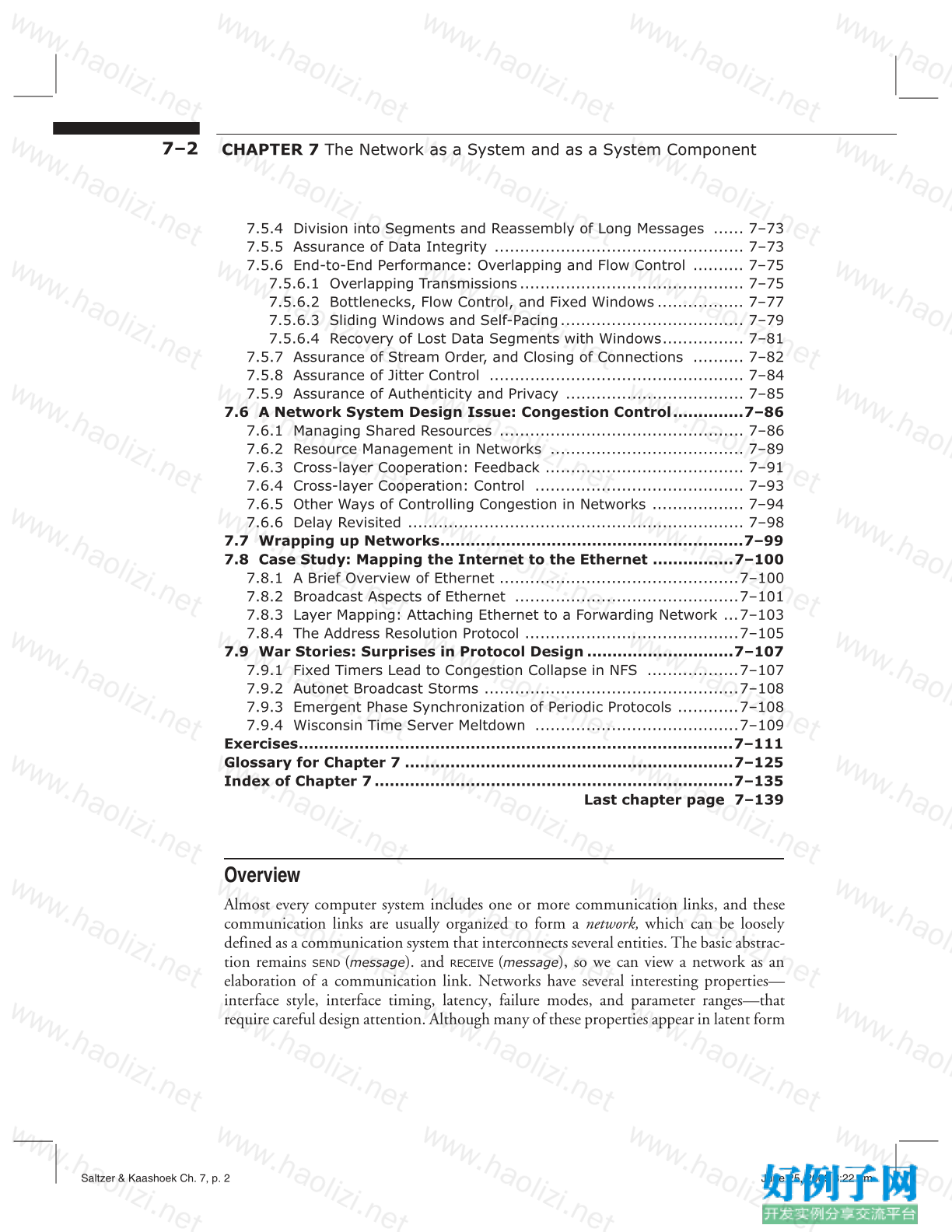

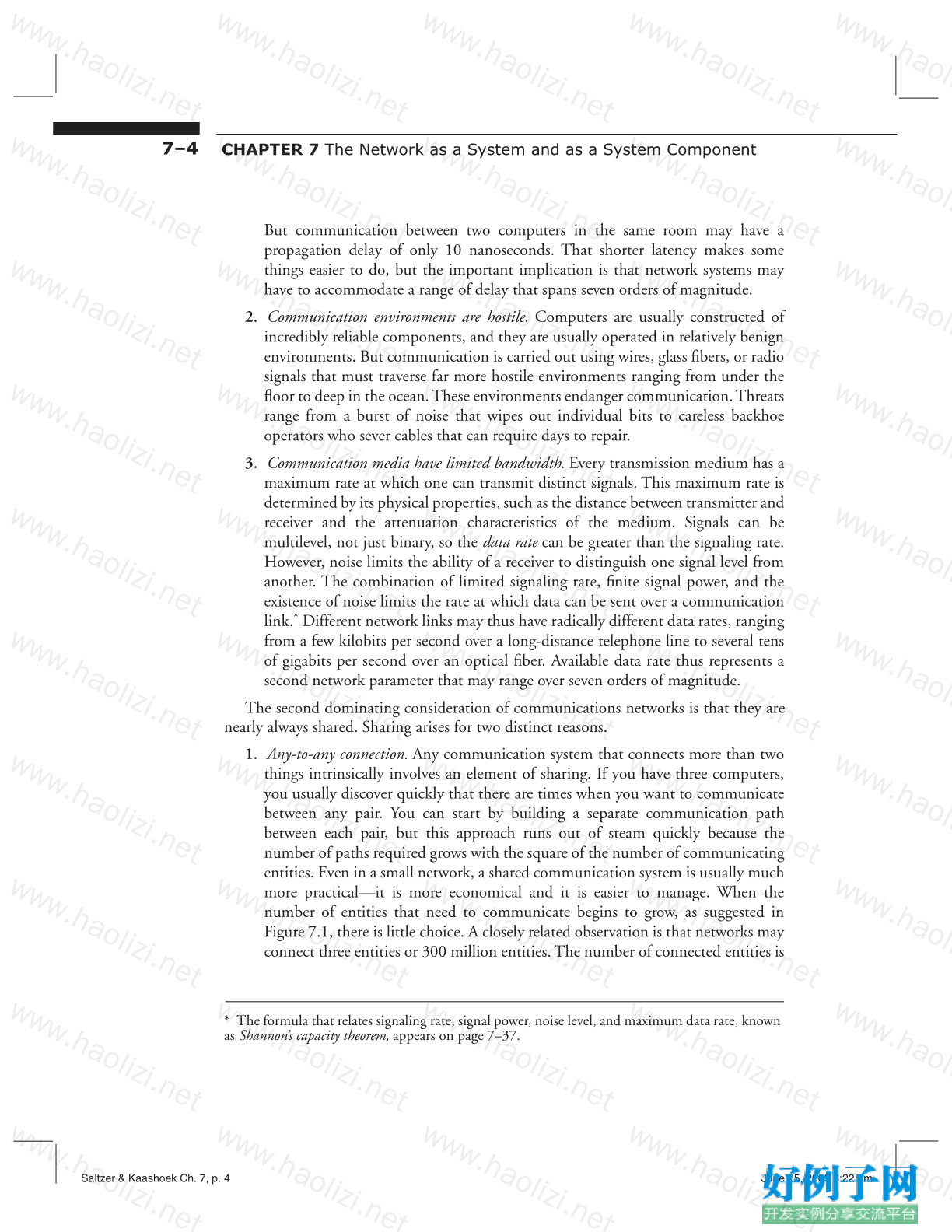
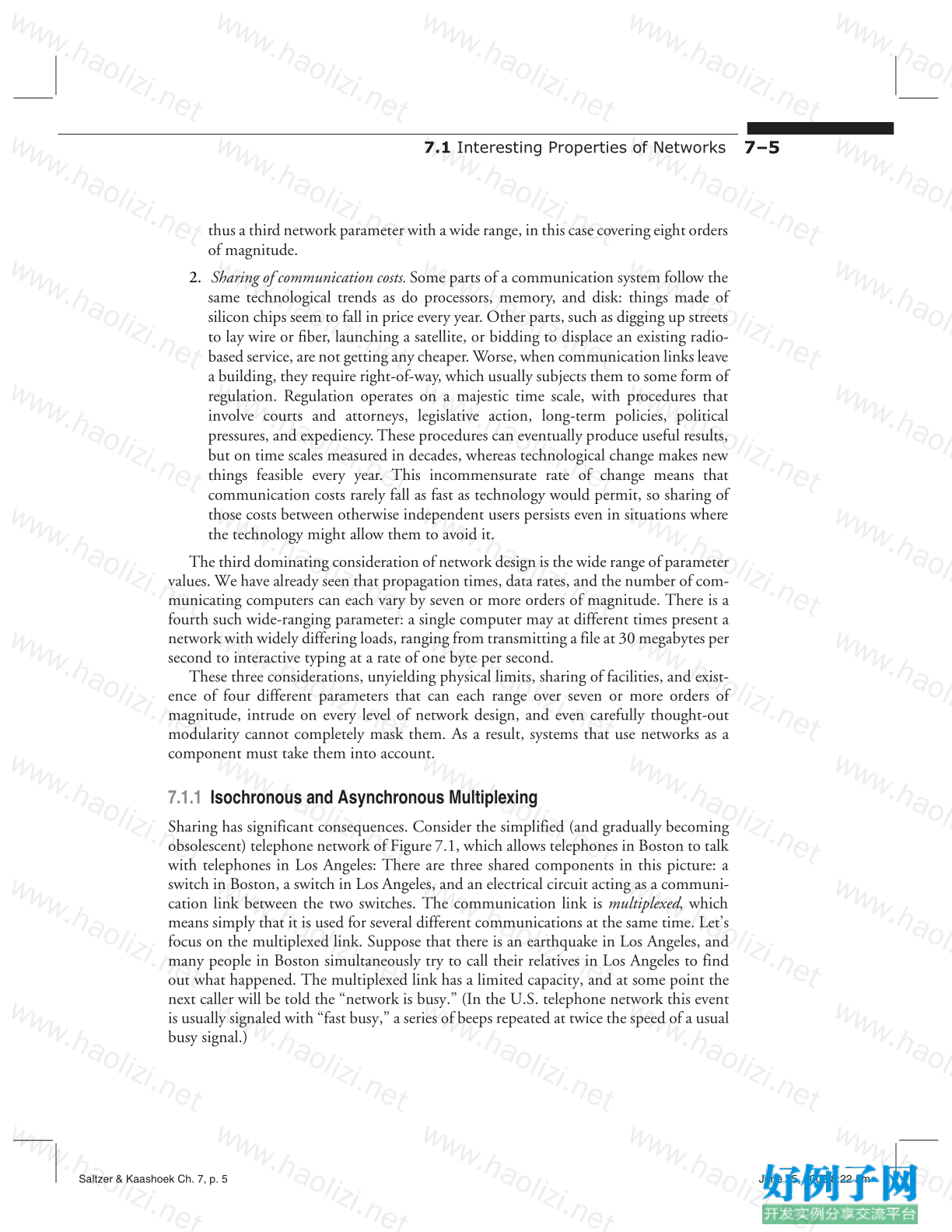
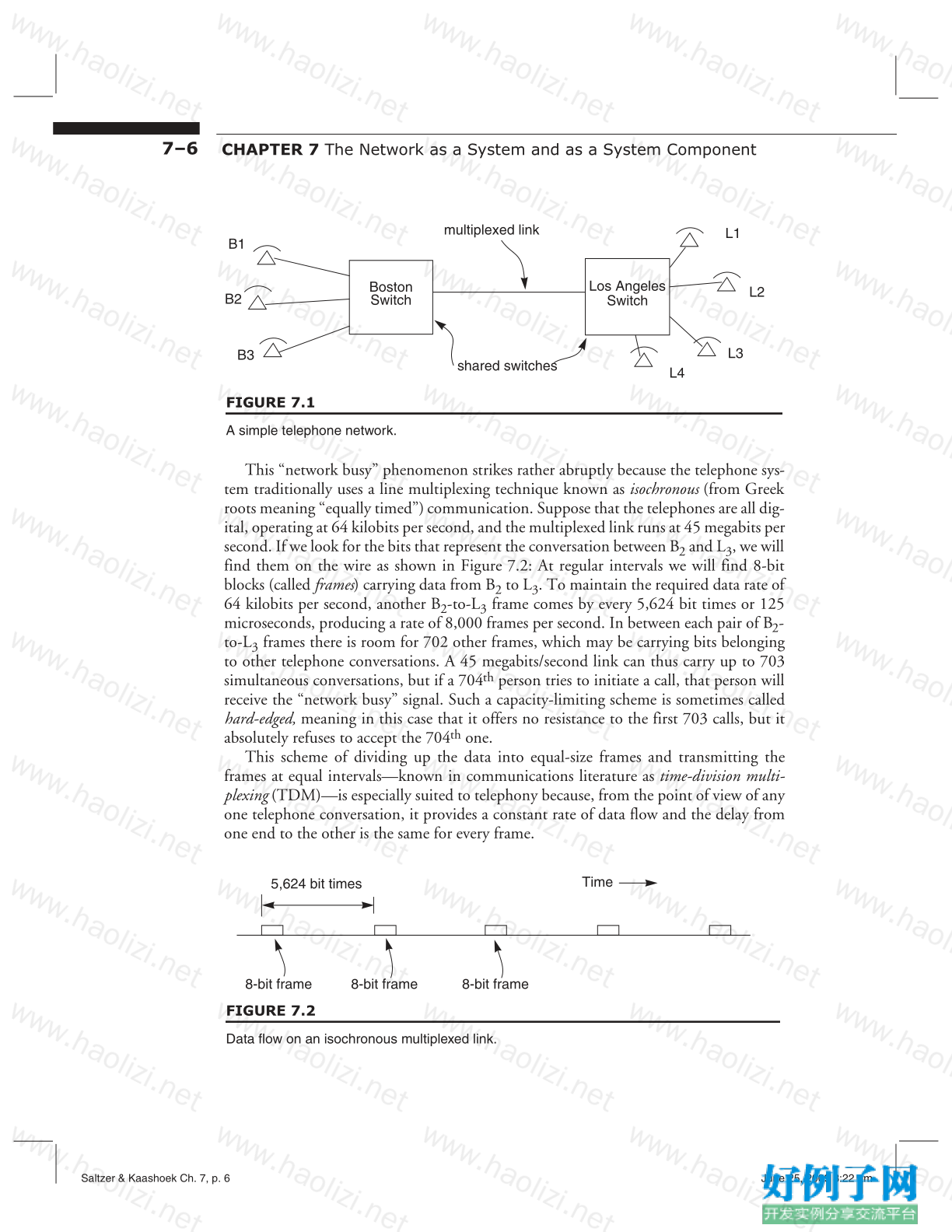




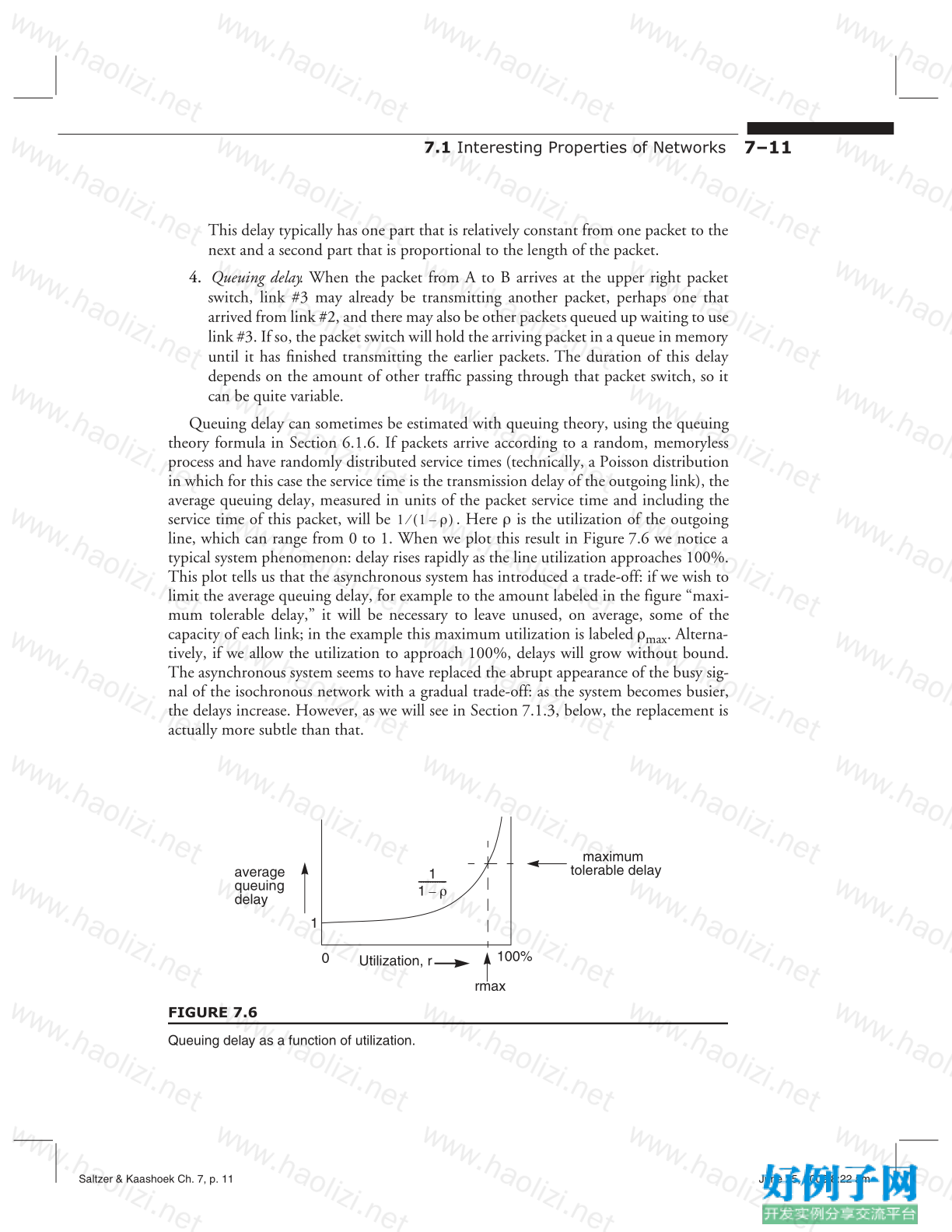

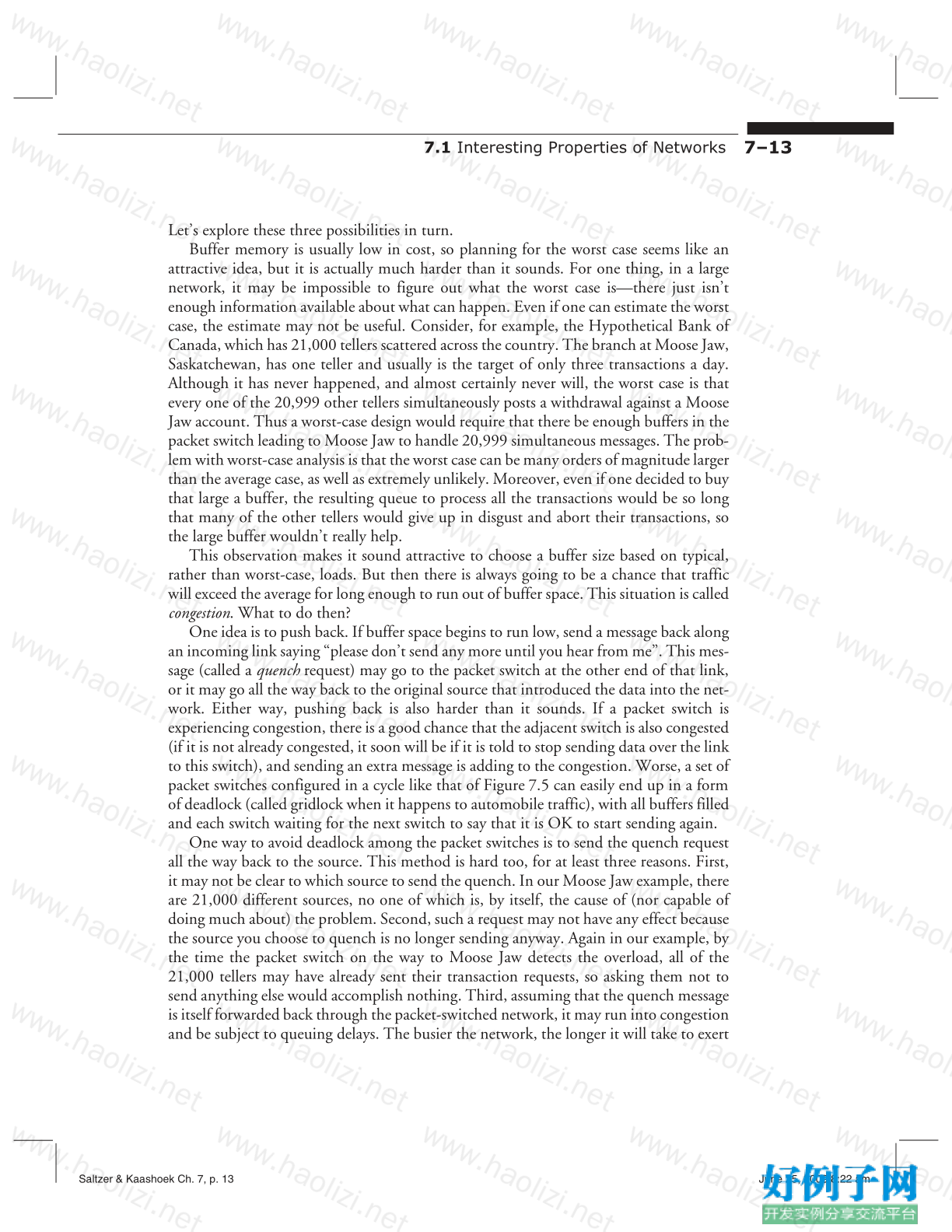
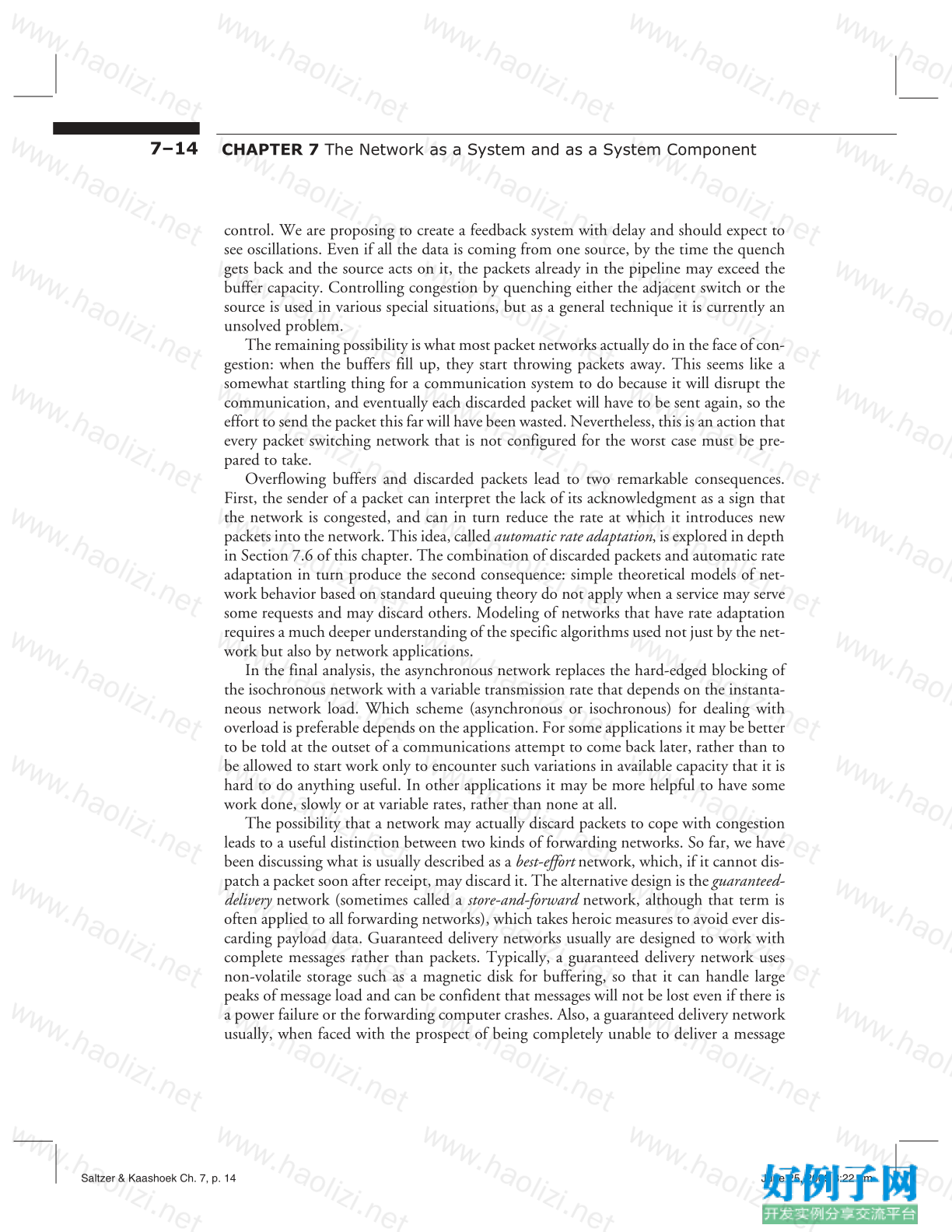
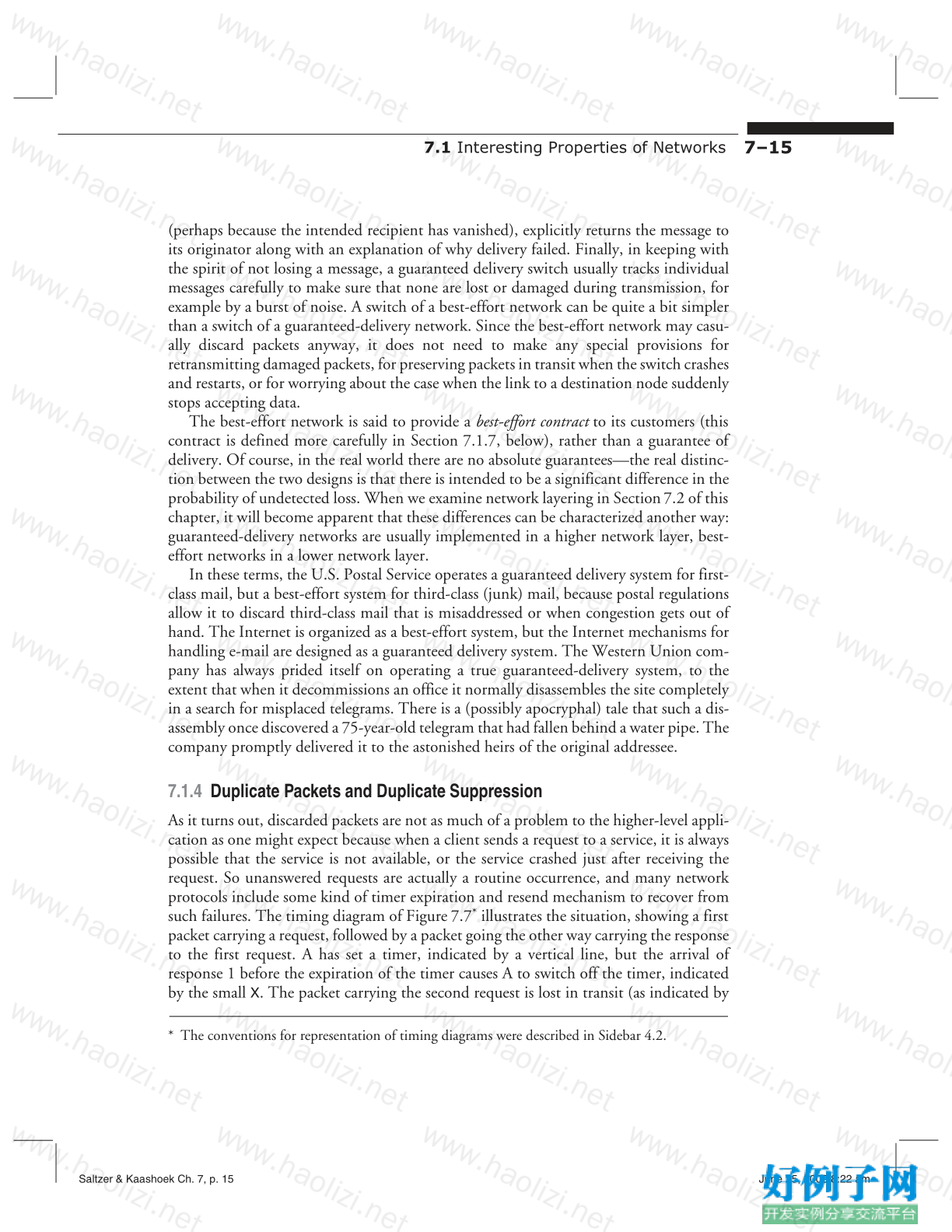

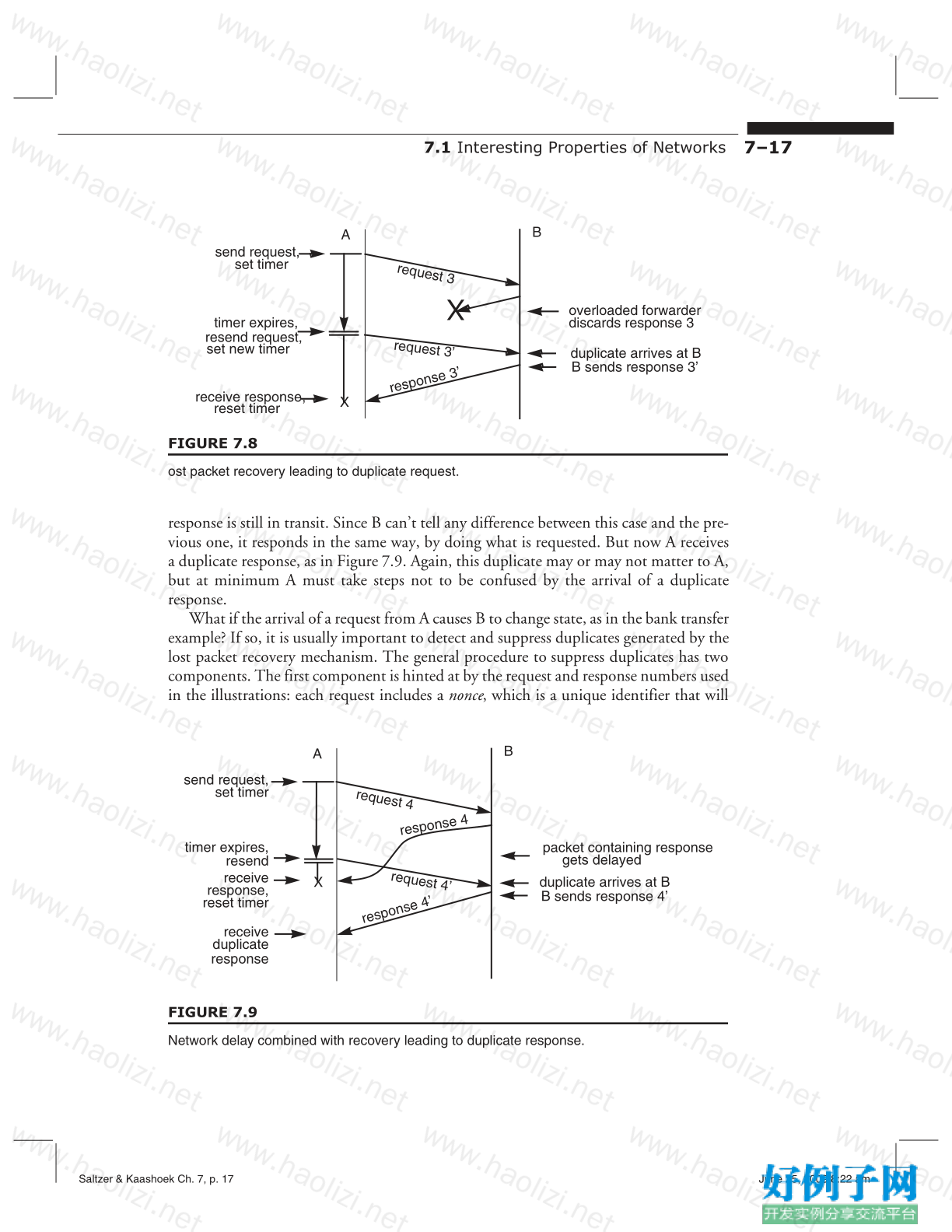

【核心代码】
Contents
PART I [In Printed Textbook]
List of Sidebars. . . . . . . . . . . . . . . . . . . . . . . . . . . . . . . . . . . . . . . . . . . . . . . . . . . . . . . . . . . . . . . . . . . . . . . .xix
Preface. . . . . . . . . . . . . . . . . . . . . . . . . . . . . . . . . . . . . . . . . . . . . . . . . . . . . . . . . . . . . . . . . . . . . . . . . . . . . xxvii
Where to Find Part II and other On-line Materials . . . . . . . . . . . . . . . . . . . . . . . . . . . . . . . . . . . . . . . . . xxxvii
Acknowledgments . . . . . . . . . . . . . . . . . . . . . . . . . . . . . . . . . . . . . . . . . . . . . . . . . . . . . . . . . . . . . . . . . . .xxxix
Computer System Design Principles . . . . . . . . . . . . . . . . . . . . . . . . . . . . . . . . . . . . . . . . . . . . . . . . . . . . . xliii
CHAPTER 1 Systems . . . . . . . . . . . . . . . . . . . . . . . . . . . . . . . . . . . . . . . . . . . . . .1
Overview. . . . . . . . . . . . . . . . . . . . . . . . . . . . . . . . . . . . . . . . . . . . . . . . . . . . . . .2
1.1. Systems and Complexity . . . . . . . . . . . . . . . . . . . . . . . . . . . . . . . . . . . . . 3
1.1.1 Common Problems of Systems in Many Fields. . . . . . . . . . . . . . . . . . 3
1.1.2 Systems, Components, Interfaces and Environments . . . . . . . . . . . . . 8
1.1.3 Complexity. . . . . . . . . . . . . . . . . . . . . . . . . . . . . . . . . . . . . . . . . . . . 10
1.2. Sources of Complexity. . . . . . . . . . . . . . . . . . . . . . . . . . . . . . . . . . . . . . 13
1.2.1 Cascading and Interacting Requirements . . . . . . . . . . . . . . . . . . . . . 13
1.2.2 Maintaining High Utilization. . . . . . . . . . . . . . . . . . . . . . . . . . . . . . 17
1.3. Coping with Complexity I. . . . . . . . . . . . . . . . . . . . . . . . . . . . . . . . . . . 19
1.3.1 Modularity . . . . . . . . . . . . . . . . . . . . . . . . . . . . . . . . . . . . . . . . . . . . 19
1.3.2 Abstraction. . . . . . . . . . . . . . . . . . . . . . . . . . . . . . . . . . . . . . . . . . . . 20
1.3.3 Layering . . . . . . . . . . . . . . . . . . . . . . . . . . . . . . . . . . . . . . . . . . . . . . 24
1.3.4 Hierarchy . . . . . . . . . . . . . . . . . . . . . . . . . . . . . . . . . . . . . . . . . . . . . 25
1.3.5 Putting it Back Together: Names Make Connections . . . . . . . . . . . . 26
1.4. Computer Systems are the Same but Different . . . . . . . . . . . . . . . . . . . . 27
1.4.1 Computer Systems Have no Nearby Bounds on Composition . . . . . 28
1.4.2 d(technology)/dt is Unprecedented. . . . . . . . . . . . . . . . . . . . . . . . . . 31
1.5. Coping with Complexity II . . . . . . . . . . . . . . . . . . . . . . . . . . . . . . . . . . 35
1.5.1 Why Modularity, Abstraction, Layering, and Hierarchy aren’t
Enough . . . . . . . . . . . . . . . . . . . . . . . . . . . . . . . . . . . . . . . . . . . . . . 36
1.5.2 Iteration . . . . . . . . . . . . . . . . . . . . . . . . . . . . . . . . . . . . . . . . . . . . . . 36
1.5.3 Keep it Simple . . . . . . . . . . . . . . . . . . . . . . . . . . . . . . . . . . . . . . . . . 39
What the Rest of this Book is about . . . . . . . . . . . . . . . . . . . . . . . . . . . . . . . . .40
Exercises . . . . . . . . . . . . . . . . . . . . . . . . . . . . . . . . . . . . . . . . . . . . . . . . . . . . . .41
iii
Saltzer & Kaashoek Ch. 0, p. iii June 24, 2009 12:21 am
iv Contents
CHAPTER 2 Elements of Computer System Organization . . . . . . . . . . . . . . 43
Overview . . . . . . . . . . . . . . . . . . . . . . . . . . . . . . . . . . . . . . . . . . . . . . . . . . . . . .44
2.1. The Three Fundamental Abstractions . . . . . . . . . . . . . . . . . . . . . . . . . . .45
2.1.1 Memory . . . . . . . . . . . . . . . . . . . . . . . . . . . . . . . . . . . . . . . . . . . . . .45
2.1.2 Interpreters . . . . . . . . . . . . . . . . . . . . . . . . . . . . . . . . . . . . . . . . . . . .53
2.1.3 Communication Links . . . . . . . . . . . . . . . . . . . . . . . . . . . . . . . . . . .59
2.2. Naming in Computer Systems . . . . . . . . . . . . . . . . . . . . . . . . . . . . . . . .60
2.2.1 The Naming Model. . . . . . . . . . . . . . . . . . . . . . . . . . . . . . . . . . . . . .61
2.2.2 Default and Explicit Context References . . . . . . . . . . . . . . . . . . . . . .66
2.2.3 Path Names, Naming Networks, and Recursive Name Resolution . . .71
2.2.4 Multiple Lookup: Searching through Layered Contexts. . . . . . . . . . .73
2.2.5 Comparing Names . . . . . . . . . . . . . . . . . . . . . . . . . . . . . . . . . . . . . .75
2.2.6 Name Discovery . . . . . . . . . . . . . . . . . . . . . . . . . . . . . . . . . . . . . . . .76
2.3. Organizing Computer Systems with Names and Layers . . . . . . . . . . . . . .78
2.3.1 A Hardware Layer: The Bus. . . . . . . . . . . . . . . . . . . . . . . . . . . . . . . .80
2.3.2 A Software Layer: The File Abstraction . . . . . . . . . . . . . . . . . . . . . . .87
2.4. Looking Back and Ahead . . . . . . . . . . . . . . . . . . . . . . . . . . . . . . . . . . . .90
2.5. Case Study: UNIX ® File System Layering and Naming . . . . . . . . . . . . . .91
2.5.1 Application Programming Interface for the UNIX File System . . . . . .91
2.5.2 The Block Layer . . . . . . . . . . . . . . . . . . . . . . . . . . . . . . . . . . . . . . . .93
2.5.3 The File Layer . . . . . . . . . . . . . . . . . . . . . . . . . . . . . . . . . . . . . . . . . .95
2.5.4 The Inode Number Layer . . . . . . . . . . . . . . . . . . . . . . . . . . . . . . . . .96
2.5.5 The File Name Layer. . . . . . . . . . . . . . . . . . . . . . . . . . . . . . . . . . . . .96
2.5.6 The Path Name Layer . . . . . . . . . . . . . . . . . . . . . . . . . . . . . . . . . . . .98
2.5.7 Links. . . . . . . . . . . . . . . . . . . . . . . . . . . . . . . . . . . . . . . . . . . . . . . . .99
2.5.8 Renaming . . . . . . . . . . . . . . . . . . . . . . . . . . . . . . . . . . . . . . . . . . . .101
2.5.9 The Absolute Path Name Layer. . . . . . . . . . . . . . . . . . . . . . . . . . . .102
2.5.10 The Symbolic Link Layer . . . . . . . . . . . . . . . . . . . . . . . . . . . . . . .104
2.5.11 Implementing the File System API . . . . . . . . . . . . . . . . . . . . . . . .106
2.5.12 The Shell, Implied Contexts, Search Paths, and Name Discovery .110
2.5.13 Suggestions for Further Reading . . . . . . . . . . . . . . . . . . . . . . . . . .112
Exercises. . . . . . . . . . . . . . . . . . . . . . . . . . . . . . . . . . . . . . . . . . . . . . . . . . . . . .112
CHAPTER 3 The Design of Naming Schemes . . . . . . . . . . . . . . . . . . . . . . . 115
Overview . . . . . . . . . . . . . . . . . . . . . . . . . . . . . . . . . . . . . . . . . . . . . . . . . . . . .115
3.1. Considerations in the Design of Naming Schemes . . . . . . . . . . . . . . . .116
3.1.1 Modular Sharing . . . . . . . . . . . . . . . . . . . . . . . . . . . . . . . . . . . . . . .116
Saltzer & Kaashoek Ch. 0, p. iv June 24, 2009 12:21 am
Contents v
3.1.2 Metadata and Name Overloading. . . . . . . . . . . . . . . . . . . . . . . . . . 120
3.1.3 Addresses: Names that Locate Objects . . . . . . . . . . . . . . . . . . . . . . 122
3.1.4 Generating Unique Names. . . . . . . . . . . . . . . . . . . . . . . . . . . . . . . 124
3.1.5 Intended Audience and User-Friendly Names. . . . . . . . . . . . . . . . . 127
3.1.6 Relative Lifetimes of Names, Values, and Bindings . . . . . . . . . . . . . 129
3.1.7 Looking Back and Ahead: Names are a Basic System Component . 131
3.2. Case Study: The Uniform Resource Locator (URL) . . . . . . . . . . . . . . . 132
3.2.1 Surfing as a Referential Experience; Name Discovery . . . . . . . . . . . 132
3.2.2 Interpretation of the URL . . . . . . . . . . . . . . . . . . . . . . . . . . . . . . . 133
3.2.3 URL Case Sensitivity . . . . . . . . . . . . . . . . . . . . . . . . . . . . . . . . . . . 134
3.2.4 Wrong Context References for a Partial URL . . . . . . . . . . . . . . . . . 135
3.2.5 Overloading of Names in URLs . . . . . . . . . . . . . . . . . . . . . . . . . . . 137
3.3. War Stories: Pathologies in the Use of Names. . . . . . . . . . . . . . . . . . . . 138
3.3.1 A Name Collision Eliminates Smiling Faces . . . . . . . . . . . . . . . . . . 139
3.3.2 Fragile Names from Overloading, and a Market Solution . . . . . . . . 139
3.3.3 More Fragile Names from Overloading, with Market Disruption . . 140
3.3.4 Case-Sensitivity in User-Friendly Names . . . . . . . . . . . . . . . . . . . . 141
3.3.5 Running Out of Telephone Numbers . . . . . . . . . . . . . . . . . . . . . . . 142
Exercises . . . . . . . . . . . . . . . . . . . . . . . . . . . . . . . . . . . . . . . . . . . . . . . . . . . . .144
CHAPTER 4 Enforcing Modularity with Clients and Services . . . . . . . . . . .147
Overview. . . . . . . . . . . . . . . . . . . . . . . . . . . . . . . . . . . . . . . . . . . . . . . . . . . . .148
4.1. Client/service organization . . . . . . . . . . . . . . . . . . . . . . . . . . . . . . . . . 149
4.1.1 From soft modularity to enforced modularity . . . . . . . . . . . . . . . . . 149
4.1.2 Client/service organization . . . . . . . . . . . . . . . . . . . . . . . . . . . . . . . 155
4.1.3 Multiple clients and services . . . . . . . . . . . . . . . . . . . . . . . . . . . . . . 163
4.1.4 Trusted intermediaries . . . . . . . . . . . . . . . . . . . . . . . . . . . . . . . . . . 163
4.1.5 A simple example service . . . . . . . . . . . . . . . . . . . . . . . . . . . . . . . . 165
4.2. Communication between client and service . . . . . . . . . . . . . . . . . . . . . 167
4.2.1 Remote procedure call (RPC). . . . . . . . . . . . . . . . . . . . . . . . . . . . . 167
4.2.2 RPCs are not identical to procedure calls . . . . . . . . . . . . . . . . . . . . 169
4.2.3 Communicating through an intermediary . . . . . . . . . . . . . . . . . . . 172
4.3. Summary and the road ahead . . . . . . . . . . . . . . . . . . . . . . . . . . . . . . . 173
4.4. Case study: The Internet Domain Name System (DNS) . . . . . . . . . . . 175
4.4.1 Name resolution in DNS . . . . . . . . . . . . . . . . . . . . . . . . . . . . . . . . 176
4.4.2 Hierarchical name management . . . . . . . . . . . . . . . . . . . . . . . . . . . 180
4.4.3 Other features of DNS . . . . . . . . . . . . . . . . . . . . . . . . . . . . . . . . . . 181
Saltzer & Kaashoek Ch. 0, p. v June 24, 2009 12:21 am
vi Contents
4.4.4 Name discovery in DNS . . . . . . . . . . . . . . . . . . . . . . . . . . . . . . . . .183
4.4.5 Trustworthiness of DNS responses . . . . . . . . . . . . . . . . . . . . . . . . .184
4.5. Case study: The Network File System (NFS). . . . . . . . . . . . . . . . . . . . .184
4.5.1 Naming remote files and directories. . . . . . . . . . . . . . . . . . . . . . . . .185
4.5.2 The NFS remote procedure calls . . . . . . . . . . . . . . . . . . . . . . . . . . .187
4.5.3 Extending the UNIX file system to support NFS. . . . . . . . . . . . . . . .190
4.5.4 Coherence. . . . . . . . . . . . . . . . . . . . . . . . . . . . . . . . . . . . . . . . . . . .192
4.5.5 NFS version 3 and beyond . . . . . . . . . . . . . . . . . . . . . . . . . . . . . . .194
Exercises. . . . . . . . . . . . . . . . . . . . . . . . . . . . . . . . . . . . . . . . . . . . . . . . . . . . . .195
CHAPTER 5 Enforcing Modularity with Virtualization . . . . . . . . . . . . . . . . . 199
Overview . . . . . . . . . . . . . . . . . . . . . . . . . . . . . . . . . . . . . . . . . . . . . . . . . . . . .200
5.1. Client/Service Organization within a Computer using Virtualization 201
5.1.1 Abstractions for Virtualizing Computers . . . . . . . . . . . . . . . . . . . . .203
5.1.1.1 Threads. . . . . . . . . . . . . . . . . . . . . . . . . . . . . . . . . . . . . . . . . .204
5.1.1.2 Virtual Memory . . . . . . . . . . . . . . . . . . . . . . . . . . . . . . . . . . .206
5.1.1.3 Bounded Buffer. . . . . . . . . . . . . . . . . . . . . . . . . . . . . . . . . . . .206
5.1.1.4 Operating System Interface. . . . . . . . . . . . . . . . . . . . . . . . . . .207
5.1.2 Emulation and Virtual Machines. . . . . . . . . . . . . . . . . . . . . . . . . . .208
5.1.3 Roadmap: Step-by-Step Virtualization. . . . . . . . . . . . . . . . . . . . . . .208
5.2. Virtual Links using SEND , RECEIVE , and a Bounded Buffer . . . . . . . . . . . .210
5.2.1 An Interface for SEND and RECEIVE with Bounded Buffers. . . . . . . . . .210
5.2.2 Sequence Coordination with a Bounded Buffer. . . . . . . . . . . . . . . .211
5.2.3 Race Conditions . . . . . . . . . . . . . . . . . . . . . . . . . . . . . . . . . . . . . . .214
5.2.4 Locks and Before-or-After Actions. . . . . . . . . . . . . . . . . . . . . . . . . .218
5.2.5 Deadlock. . . . . . . . . . . . . . . . . . . . . . . . . . . . . . . . . . . . . . . . . . . . .221
5.2.6 Implementing ACQUIRE and RELEASE . . . . . . . . . . . . . . . . . . . . . . . . . .222
5.2.7 Implementing a Before-or-After Action Using the One-Writer
Principle . . . . . . . . . . . . . . . . . . . . . . . . . . . . . . . . . . . . . . . . . . . . .225
5.2.8 Coordination between Synchronous Islands with Asynchronous
Connections . . . . . . . . . . . . . . . . . . . . . . . . . . . . . . . . . . . . . . . . . .228
5.3. Enforcing Modularity in Memory. . . . . . . . . . . . . . . . . . . . . . . . . . . . .230
5.3.1 Enforcing Modularity with Domains. . . . . . . . . . . . . . . . . . . . . . . .230
5.3.2 Controlled Sharing using Several Domains . . . . . . . . . . . . . . . . . . .231
5.3.3 More Enforced Modularity with Kernel and User Mode . . . . . . . . .234
5.3.4 Gates and Changing Modes. . . . . . . . . . . . . . . . . . . . . . . . . . . . . . .235
5.3.5 Enforcing Modularity for Bounded Buffers . . . . . . . . . . . . . . . . . . .237
Saltzer & Kaashoek Ch. 0, p. vi June 24, 2009 12:21 am
Contents vii
5.3.6 The Kernel. . . . . . . . . . . . . . . . . . . . . . . . . . . . . . . . . . . . . . . . . . . 238
5.4. Virtualizing Memory. . . . . . . . . . . . . . . . . . . . . . . . . . . . . . . . . . . . . . 242
5.4.1 Virtualizing Addresses. . . . . . . . . . . . . . . . . . . . . . . . . . . . . . . . . . . 243
5.4.2 Translating Addresses using a Page Map . . . . . . . . . . . . . . . . . . . . . 245
5.4.3 Virtual Address Spaces . . . . . . . . . . . . . . . . . . . . . . . . . . . . . . . . . . 248
5.4.3.1 Primitives for Virtual Address Spaces . . . . . . . . . . . . . . . . . . . 248
5.4.3.2 The Kernel and Address Spaces . . . . . . . . . . . . . . . . . . . . . . . 250
5.4.3.3 Discussion . . . . . . . . . . . . . . . . . . . . . . . . . . . . . . . . . . . . . . . 251
5.4.4 Hardware versus Software and the Translation Look-Aside Buffer. . 252
5.4.5 Segments (Advanced Topic) . . . . . . . . . . . . . . . . . . . . . . . . . . . . . . 253
5.5. Virtualizing Processors using Threads . . . . . . . . . . . . . . . . . . . . . . . . . 255
5.5.1 Sharing a processor among multiple threads . . . . . . . . . . . . . . . . . . 255
5.5.2 Implementing YIELD . . . . . . . . . . . . . . . . . . . . . . . . . . . . . . . . . . . . . 260
5.5.3 Creating and Terminating Threads . . . . . . . . . . . . . . . . . . . . . . . . . 264
5.5.4 Enforcing Modularity with Threads: Preemptive Scheduling . . . . . 269
5.5.5 Enforcing Modularity with Threads and Address Spaces. . . . . . . . . 271
5.5.6 Layering Threads . . . . . . . . . . . . . . . . . . . . . . . . . . . . . . . . . . . . . . 271
5.6. Thread Primitives for Sequence Coordination . . . . . . . . . . . . . . . . . . . 273
5.6.1 The Lost Notification Problem. . . . . . . . . . . . . . . . . . . . . . . . . . . . 273
5.6.2 Avoiding the Lost Notification Problem with Eventcounts and
Sequencers . . . . . . . . . . . . . . . . . . . . . . . . . . . . . . . . . . . . . . . . . . . 275
5.6.3 Implementing AWAIT , ADVANCE , TICKET , and READ (Advanced
Topic). . . . . . . . . . . . . . . . . . . . . . . . . . . . . . . . . . . . . . . . . . . . . . . 280
5.6.4 Polling, Interrupts, and Sequence coordination. . . . . . . . . . . . . . . . 282
5.7. Case study: Evolution of Enforced Modularity in the Intel x86 . . . . . . 284
5.7.1 The early designs: no support for enforced modularity . . . . . . . . . . 285
5.7.2 Enforcing Modularity using Segmentation . . . . . . . . . . . . . . . . . . . 286
5.7.3 Page-Based Virtual Address Spaces . . . . . . . . . . . . . . . . . . . . . . . . . 287
5.7.4 Summary: more evolution . . . . . . . . . . . . . . . . . . . . . . . . . . . . . . . 288
5.8. Application: Enforcing Modularity using Virtual Machines . . . . . . . . . 290
5.8.1 Virtual Machine Uses. . . . . . . . . . . . . . . . . . . . . . . . . . . . . . . . . . . 290
5.8.2 Implementing Virtual Machines. . . . . . . . . . . . . . . . . . . . . . . . . . . 291
5.8.3 Virtualizing Example . . . . . . . . . . . . . . . . . . . . . . . . . . . . . . . . . . . 293
Exercises . . . . . . . . . . . . . . . . . . . . . . . . . . . . . . . . . . . . . . . . . . . . . . . . . . . . .294
CHAPTER 6 Performance . . . . . . . . . . . . . . . . . . . . . . . . . . . . . . . . . . . . . . . .299
Overview. . . . . . . . . . . . . . . . . . . . . . . . . . . . . . . . . . . . . . . . . . . . . . . . . . . . .300
Saltzer & Kaashoek Ch. 0, p. vii June 24, 2009 12:21 am
viii Contents
6.1. Designing for Performance . . . . . . . . . . . . . . . . . . . . . . . . . . . . . . . . . .300
6.1.1 Performance Metrics . . . . . . . . . . . . . . . . . . . . . . . . . . . . . . . . . . . .302
6.1.1.1 Capacity, Utilization, Overhead, and Useful Work . . . . . . . . .302
6.1.1.2 Latency . . . . . . . . . . . . . . . . . . . . . . . . . . . . . . . . . . . . . . . . . .302
6.1.1.3 Throughput . . . . . . . . . . . . . . . . . . . . . . . . . . . . . . . . . . . . . .303
6.1.2 A Systems Approach to Designing for Performance . . . . . . . . . . . . .304
6.1.3 Reducing latency by exploiting workload properties . . . . . . . . . . . .306
6.1.4 Reducing Latency Using Concurrency. . . . . . . . . . . . . . . . . . . . . . .307
6.1.5 Improving Throughput: Concurrency . . . . . . . . . . . . . . . . . . . . . . .309
6.1.6 Queuing and Overload . . . . . . . . . . . . . . . . . . . . . . . . . . . . . . . . . .311
6.1.7 Fighting Bottlenecks . . . . . . . . . . . . . . . . . . . . . . . . . . . . . . . . . . . .313
6.1.7.1 Batching . . . . . . . . . . . . . . . . . . . . . . . . . . . . . . . . . . . . . . . . .314
6.1.7.2 Dallying . . . . . . . . . . . . . . . . . . . . . . . . . . . . . . . . . . . . . . . . .314
6.1.7.3 Speculation . . . . . . . . . . . . . . . . . . . . . . . . . . . . . . . . . . . . . . .314
6.1.7.4 Challenges with Batching, Dallying, and Speculation . . . . . . .315
6.1.8 An Example: the I/O bottleneck . . . . . . . . . . . . . . . . . . . . . . . . . . .316
6.2. Multilevel Memories. . . . . . . . . . . . . . . . . . . . . . . . . . . . . . . . . . . . . . .321
6.2.1 Memory Characterization . . . . . . . . . . . . . . . . . . . . . . . . . . . . . . . .322
6.2.2 Multilevel Memory Management using Virtual Memory. . . . . . . . .323
6.2.3 Adding multilevel memory management to a virtual memory . . . . .327
6.2.4 Analyzing Multilevel Memory Systems . . . . . . . . . . . . . . . . . . . . . .331
6.2.5 Locality of reference and working sets . . . . . . . . . . . . . . . . . . . . . . .333
6.2.6 Multilevel Memory Management Policies . . . . . . . . . . . . . . . . . . . .335
6.2.7 Comparative analysis of different policies . . . . . . . . . . . . . . . . . . . .340
6.2.8 Other Page-Removal Algorithms . . . . . . . . . . . . . . . . . . . . . . . . . . .344
6.2.9 Other aspects of multilevel memory management . . . . . . . . . . . . . .346
6.3. Scheduling . . . . . . . . . . . . . . . . . . . . . . . . . . . . . . . . . . . . . . . . . . . . . .347
6.3.1 Scheduling Resources . . . . . . . . . . . . . . . . . . . . . . . . . . . . . . . . . . .348
6.3.2 Scheduling metrics . . . . . . . . . . . . . . . . . . . . . . . . . . . . . . . . . . . . .349
6.3.3 Scheduling Policies . . . . . . . . . . . . . . . . . . . . . . . . . . . . . . . . . . . . .352
6.3.3.1 First-Come, First-Served . . . . . . . . . . . . . . . . . . . . . . . . . . . . .353
6.3.3.2 Shortest-job-first . . . . . . . . . . . . . . . . . . . . . . . . . . . . . . . . . . .354
6.3.3.3 Round-Robin . . . . . . . . . . . . . . . . . . . . . . . . . . . . . . . . . . . . .355
6.3.3.4 Priority Scheduling . . . . . . . . . . . . . . . . . . . . . . . . . . . . . . . . .357
6.3.3.5 Real-time Schedulers. . . . . . . . . . . . . . . . . . . . . . . . . . . . . . . .359
Saltzer & Kaashoek Ch. 0, p. viii June 24, 2009 12:21 am
Contents ix
6.3.4 Case study: Scheduling the Disk Arm. . . . . . . . . . . . . . . . . . . . . . . 360
Exercises . . . . . . . . . . . . . . . . . . . . . . . . . . . . . . . . . . . . . . . . . . . . . . . . . . . . .362
About Part II . . . . . . . . . . . . . . . . . . . . . . . . . . . . . . . . . . . . . . . . . . . . . . . . . . . . . . . . . . . . . . . . . . . . . . . . . 369
Appendix A: The Binary Classification Trade-off . . . . . . . . . . . . . . . . . . . . . . . . . . . . . . . . . . . . . . . . . . . 371
Suggestions for Further Reading . . . . . . . . . . . . . . . . . . . . . . . . . . . . . . . . . . . . . . . . . . . . . . . . . . . . . . . . 375
Problem Sets for Part I. . . . . . . . . . . . . . . . . . . . . . . . . . . . . . . . . . . . . . . . . . . . . . . . . . . . . . . . . . . . . . . . . 425
Glossary . . . . . . . . . . . . . . . . . . . . . . . . . . . . . . . . . . . . . . . . . . . . . . . . . . . . . . . . . . . . . . . . . . . . . . . . . . . . 475
Index of Concepts. . . . . . . . . . . . . . . . . . . . . . . . . . . . . . . . . . . . . . . . . . . . . . . . . . . . . . . . . . . . . . . . . . . . . 513
Part II [On-Line]
CHAPTER 7 The Network as a System and as a System Component . . . .7–1
Overview. . . . . . . . . . . . . . . . . . . . . . . . . . . . . . . . . . . . . . . . . . . . . . . . . . . . .7–2
7.1. Interesting Properties of Networks. . . . . . . . . . . . . . . . . . . . . . . . . . . 7–3
7.1.1 Isochronous and Asynchronous Multiplexing . . . . . . . . . . . . . . . . . 7–5
7.1.2 Packet Forwarding; Delay. . . . . . . . . . . . . . . . . . . . . . . . . . . . . . . . 7–9
7.1.3 Buffer Overflow and Discarded Packets . . . . . . . . . . . . . . . . . . . . 7–12
7.1.4 Duplicate Packets and Duplicate Suppression. . . . . . . . . . . . . . . . 7–15
7.1.5 Damaged Packets and Broken Links. . . . . . . . . . . . . . . . . . . . . . . 7–18
7.1.6 Reordered Delivery. . . . . . . . . . . . . . . . . . . . . . . . . . . . . . . . . . . . 7–19
7.1.7 Summary of Interesting Properties and the Best-Effort Contract . 7–20
7.2. Getting Organized: Layers . . . . . . . . . . . . . . . . . . . . . . . . . . . . . . . . 7–20
7.2.1 Layers. . . . . . . . . . . . . . . . . . . . . . . . . . . . . . . . . . . . . . . . . . . . . . 7–23
7.2.2 The Link Layer. . . . . . . . . . . . . . . . . . . . . . . . . . . . . . . . . . . . . . . 7–25
7.2.3 The Network Layer . . . . . . . . . . . . . . . . . . . . . . . . . . . . . . . . . . . 7–27
7.2.4 The End-to-End Layer . . . . . . . . . . . . . . . . . . . . . . . . . . . . . . . . . 7–28
7.2.5 Additional Layers and the End-to-End Argument. . . . . . . . . . . . . 7–30
7.2.6 Mapped and Recursive Applications of the Layered Model . . . . . . 7–32
7.3. The Link Layer. . . . . . . . . . . . . . . . . . . . . . . . . . . . . . . . . . . . . . . . . 7–34
7.3.1 Transmitting Digital Data in an Analog World . . . . . . . . . . . . . . . 7–34
7.3.2 Framing Frames . . . . . . . . . . . . . . . . . . . . . . . . . . . . . . . . . . . . . . 7–38
7.3.3 Error Handling. . . . . . . . . . . . . . . . . . . . . . . . . . . . . . . . . . . . . . . 7–40
7.3.4 The Link Layer Interface: Link Protocols and Multiplexing . . . . . 7–41
7.3.5 Link Properties. . . . . . . . . . . . . . . . . . . . . . . . . . . . . . . . . . . . . . . 7–44
Saltzer & Kaashoek Ch. 0, p. ix June 24, 2009 12:21 am
x Contents
7.4. The Network Layer . . . . . . . . . . . . . . . . . . . . . . . . . . . . . . . . . . . . . .7–46
7.4.1 Addressing Interface . . . . . . . . . . . . . . . . . . . . . . . . . . . . . . . . . . .7–46
7.4.2 Managing the Forwarding Table: Routing . . . . . . . . . . . . . . . . . . .7–48
7.4.3 Hierarchical Address Assignment and Hierarchical Routing. . . . . .7–56
7.4.4 Reporting Network Layer Errors . . . . . . . . . . . . . . . . . . . . . . . . . .7–59
7.4.5 Network Address Translation (An Idea That Almost Works) . . . . .7–61
7.5. The End-to-End Layer. . . . . . . . . . . . . . . . . . . . . . . . . . . . . . . . . . . .7–62
7.5.1 Transport Protocols and Protocol Multiplexing . . . . . . . . . . . . . . .7–63
7.5.2 Assurance of At-Least-Once Delivery; the Role of Timers . . . . . . .7–67
7.5.3 Assurance of At-Most-Once Delivery: Duplicate Suppression . . . .7–71
7.5.4 Division into Segments and Reassembly of Long Messages . . . . . .7–73
7.5.5 Assurance of Data Integrity . . . . . . . . . . . . . . . . . . . . . . . . . . . . . .7–73
7.5.6 End-to-End Performance: Overlapping and Flow Control. . . . . . .7–75
7.5.6.1 Overlapping Transmissions . . . . . . . . . . . . . . . . . . . . . . . . . .7–75
7.5.6.2 Bottlenecks, Flow Control, and Fixed Windows . . . . . . . . . .7–77
7.5.6.3 Sliding Windows and Self-Pacing . . . . . . . . . . . . . . . . . . . . .7–79
7.5.6.4 Recovery of Lost Data Segments with Windows . . . . . . . . . .7–81
7.5.7 Assurance of Stream Order, and Closing of Connections. . . . . . . .7–82
7.5.8 Assurance of Jitter Control . . . . . . . . . . . . . . . . . . . . . . . . . . . . . .7–84
7.5.9 Assurance of Authenticity and Privacy. . . . . . . . . . . . . . . . . . . . . .7–85
7.6. A Network System Design Issue: Congestion Control . . . . . . . . . . . . 7–86
7.6.1 Managing Shared Resources . . . . . . . . . . . . . . . . . . . . . . . . . . . . .7–86
7.6.2 Resource Management in Networks . . . . . . . . . . . . . . . . . . . . . . .7–89
7.6.3 Cross-layer Cooperation: Feedback . . . . . . . . . . . . . . . . . . . . . . . .7–91
7.6.4 Cross-layer Cooperation: Control . . . . . . . . . . . . . . . . . . . . . . . . .7–93
7.6.5 Other Ways of Controlling Congestion in Networks . . . . . . . . . . .7–94
7.6.6 Delay Revisited . . . . . . . . . . . . . . . . . . . . . . . . . . . . . . . . . . . . . . .7–98
7.7. Wrapping up Networks . . . . . . . . . . . . . . . . . . . . . . . . . . . . . . . . . . .7–99
7.8. Case Study: Mapping the Internet to the Ethernet. . . . . . . . . . . . . . 7–100
7.8.1 A Brief Overview of Ethernet . . . . . . . . . . . . . . . . . . . . . . . . . . .7–100
7.8.2 Broadcast Aspects of Ethernet . . . . . . . . . . . . . . . . . . . . . . . . . . .7–101
7.8.3 Layer Mapping: Attaching Ethernet to a Forwarding Network . .7–103
7.8.4 The Address Resolution Protocol. . . . . . . . . . . . . . . . . . . . . . . . .7–105
7.9. War Stories: Surprises in Protocol Design . . . . . . . . . . . . . . . . . . . .7–107
7.9.1 Fixed Timers Lead to Congestion Collapse in NFS . . . . . . . . . . .7–107
7.9.2 Autonet Broadcast Storms . . . . . . . . . . . . . . . . . . . . . . . . . . . . . .7–108
7.9.3 Emergent Phase Synchronization of Periodic Protocols . . . . . . . .7–108
Saltzer & Kaashoek Ch. 0, p. x June 24, 2009 12:21 am
Contents xi
7.9.4 Wisconsin Time Server Meltdown . . . . . . . . . . . . . . . . . . . . . . . 7–109
Exercises . . . . . . . . . . . . . . . . . . . . . . . . . . . . . . . . . . . . . . . . . . . . . . . . . . .7–111
CHAPTER 8 Fault Tolerance: Reliable Systems from Unreliable Components
8–1
Overview. . . . . . . . . . . . . . . . . . . . . . . . . . . . . . . . . . . . . . . . . . . . . . . . . . . . .8–2
8.1. Faults, Failures, and Fault Tolerant Design. . . . . . . . . . . . . . . . . . . . . 8–3
8.1.1 Faults, Failures, and Modules . . . . . . . . . . . . . . . . . . . . . . . . . . . . . 8–3
8.1.2 The Fault-Tolerance Design Process . . . . . . . . . . . . . . . . . . . . . . . . 8–6
8.2. Measures of Reliability and Failure Tolerance. . . . . . . . . . . . . . . . . . . 8–8
8.2.1 Availability and Mean Time to Failure . . . . . . . . . . . . . . . . . . . . . . 8–8
8.2.2 Reliability Functions. . . . . . . . . . . . . . . . . . . . . . . . . . . . . . . . . . . 8–13
8.2.3 Measuring Fault Tolerance . . . . . . . . . . . . . . . . . . . . . . . . . . . . . . 8–16
8.3. Tolerating Active Faults . . . . . . . . . . . . . . . . . . . . . . . . . . . . . . . . . . 8–16
8.3.1 Responding to Active Faults . . . . . . . . . . . . . . . . . . . . . . . . . . . . . 8–16
8.3.2 Fault Tolerance Models. . . . . . . . . . . . . . . . . . . . . . . . . . . . . . . . . 8–18
8.4. Systematically Applying Redundancy . . . . . . . . . . . . . . . . . . . . . . . . 8–20
8.4.1 Coding: Incremental Redundancy . . . . . . . . . . . . . . . . . . . . . . . . 8–21
8.4.2 Replication: Massive Redundancy. . . . . . . . . . . . . . . . . . . . . . . . . 8–25
8.4.3 Voting . . . . . . . . . . . . . . . . . . . . . . . . . . . . . . . . . . . . . . . . . . . . . 8–26
8.4.4 Repair. . . . . . . . . . . . . . . . . . . . . . . . . . . . . . . . . . . . . . . . . . . . . . 8–31
8.5. Applying Redundancy to Software and Data . . . . . . . . . . . . . . . . . . 8–36
8.5.1 Tolerating Software Faults. . . . . . . . . . . . . . . . . . . . . . . . . . . . . . . 8–36
8.5.2 Tolerating Software (and other) Faults by Separating State . . . . . . 8–37
8.5.3 Durability and Durable Storage . . . . . . . . . . . . . . . . . . . . . . . . . . 8–39
8.5.4 Magnetic Disk Fault Tolerance . . . . . . . . . . . . . . . . . . . . . . . . . . . 8–40
8.5.4.1 Magnetic Disk Fault Modes . . . . . . . . . . . . . . . . . . . . . . . . . 8–41
8.5.4.2 System Faults . . . . . . . . . . . . . . . . . . . . . . . . . . . . . . . . . . . . 8–42
8.5.4.3 Raw Disk Storage. . . . . . . . . . . . . . . . . . . . . . . . . . . . . . . . . 8–43
8.5.4.4 Fail-Fast Disk Storage. . . . . . . . . . . . . . . . . . . . . . . . . . . . . . 8–43
8.5.4.5 Careful Disk Storage . . . . . . . . . . . . . . . . . . . . . . . . . . . . . . 8–45
8.5.4.6 Durable Storage: RAID 1. . . . . . . . . . . . . . . . . . . . . . . . . . . 8–46
8.5.4.7 Improving on RAID 1 . . . . . . . . . . . . . . . . . . . . . . . . . . . . . 8–47
8.5.4.8 Detecting Errors Caused by System Crashes. . . . . . . . . . . . . 8–49
8.5.4.9 Still More Threats to Durability . . . . . . . . . . . . . . . . . . . . . . 8–49
Saltzer & Kaashoek Ch. 0, p. xi June 24, 2009 12:21 am
xii Contents
8.6. Wrapping up Reliability. . . . . . . . . . . . . . . . . . . . . . . . . . . . . . . . . . .8–51
8.6.1 Design Strategies and Design Principles. . . . . . . . . . . . . . . . . . . . .8–51
8.6.2 How about the End-to-End Argument?. . . . . . . . . . . . . . . . . . . . .8–52
8.6.3 A Caution on the Use of Reliability Calculations. . . . . . . . . . . . . .8–53
8.6.4 Where to Learn More about Reliable Systems . . . . . . . . . . . . . . . .8–53
8.7. Application: A Fault Tolerance Model for CMOS RAM . . . . . . . . . . 8–55
8.8. War Stories: Fault Tolerant Systems that Failed . . . . . . . . . . . . . . . . . 8–57
8.8.1 Adventures with Error Correction . . . . . . . . . . . . . . . . . . . . . . . . .8–57
8.8.2 Risks of Rarely-Used Procedures: The National Archives . . . . . . . .8–59
8.8.3 Non-independent Replicas and Backhoe Fade . . . . . . . . . . . . . . . .8–60
8.8.4 Human Error May Be the Biggest Risk . . . . . . . . . . . . . . . . . . . . .8–61
8.8.5 Introducing a Single Point of Failure . . . . . . . . . . . . . . . . . . . . . . .8–63
8.8.6 Multiple Failures: The SOHO Mission Interruption . . . . . . . . . . .8–63
Exercises. . . . . . . . . . . . . . . . . . . . . . . . . . . . . . . . . . . . . . . . . . . . . . . . . . . . .8–64
CHAPTER 9 Atomicity: All-or-Nothing and Before-or-After . . . . . . . . . . . . 9–1
Overview . . . . . . . . . . . . . . . . . . . . . . . . . . . . . . . . . . . . . . . . . . . . . . . . . . . . .9–2
9.1. Atomicity. . . . . . . . . . . . . . . . . . . . . . . . . . . . . . . . . . . . . . . . . . . . . . .9–4
9.1.1 All-or-Nothing Atomicity in a Database . . . . . . . . . . . . . . . . . . . . .9–5
9.1.2 All-or-Nothing Atomicity in the Interrupt Interface . . . . . . . . . . . .9–6
9.1.3 All-or-Nothing Atomicity in a Layered Application . . . . . . . . . . . . .9–8
9.1.4 Some Actions With and Without the All-or-Nothing Property . . .9–10
9.1.5 Before-or-After Atomicity: Coordinating Concurrent Threads. . . .9–13
9.1.6 Correctness and Serialization. . . . . . . . . . . . . . . . . . . . . . . . . . . . .9–16
9.1.7 All-or-Nothing and Before-or-After Atomicity. . . . . . . . . . . . . . . .9–19
9.2. All-or-Nothing Atomicity I: Concepts . . . . . . . . . . . . . . . . . . . . . . . .9–21
9.2.1 Achieving All-or-Nothing Atomicity: ALL _ OR _ NOTHING _ PUT . . .9–21
9.2.2 Systematic Atomicity: Commit and the Golden Rule . . . . . . . . . .9–27
9.2.3 Systematic All-or-Nothing Atomicity: Version Histories . . . . . . . .9–30
9.2.4 How Version Histories are Used . . . . . . . . . . . . . . . . . . . . . . . . . .9–37
9.3. All-or-Nothing Atomicity II: Pragmatics . . . . . . . . . . . . . . . . . . . . . .9–38
9.3.1 Atomicity Logs . . . . . . . . . . . . . . . . . . . . . . . . . . . . . . . . . . . . . . .9–39
9.3.2 Logging Protocols . . . . . . . . . . . . . . . . . . . . . . . . . . . . . . . . . . . . .9–42
9.3.3 Recovery Procedures . . . . . . . . . . . . . . . . . . . . . . . . . . . . . . . . . . .9–45
9.3.4 Other Logging Configurations: Non-Volatile Cell Storage. . . . . . .9–47
9.3.5 Checkpoints . . . . . . . . . . . . . . . . . . . . . . . . . . . . . . . . . . . . . . . . .9–51
9.3.6 What if the Cache is not Write-Through? (Advanced Topic) . . . . .9–53
Saltzer & Kaashoek Ch. 0, p. xii June 24, 2009 12:21 am
Contents xiii
9.4. Before-or-After Atomicity I: Concepts . . . . . . . . . . . . . . . . . . . . . . . 9–54
9.4.1 Achieving Before-or-After Atomicity: Simple Serialization . . . . . . 9–54
9.4.2 The Mark-Point Discipline. . . . . . . . . . . . . . . . . . . . . . . . . . . . . . 9–58
9.4.3 Optimistic Atomicity: Read-Capture (Advanced Topic) . . . . . . . . 9–63
9.4.4 Does Anyone Actually Use Version Histories for Before-or-After
Atomicity? . . . . . . . . . . . . . . . . . . . . . . . . . . . . . . . . . . . . . . . . . . 9–67
9.5. Before-or-After Atomicity II: Pragmatics . . . . . . . . . . . . . . . . . . . . . 9–69
9.5.1 Locks . . . . . . . . . . . . . . . . . . . . . . . . . . . . . . . . . . . . . . . . . . . . . . 9–70
9.5.2 Simple Locking. . . . . . . . . . . . . . . . . . . . . . . . . . . . . . . . . . . . . . . 9–72
9.5.3 Two-Phase Locking. . . . . . . . . . . . . . . . . . . . . . . . . . . . . . . . . . . . 9–73
9.5.4 Performance Optimizations . . . . . . . . . . . . . . . . . . . . . . . . . . . . . 9–75
9.5.5 Deadlock; Making Progress . . . . . . . . . . . . . . . . . . . . . . . . . . . . . 9–76
9.6. Atomicity across Layers and Multiple Sites. . . . . . . . . . . . . . . . . . . . 9–79
9.6.1 Hierarchical Composition of Transactions . . . . . . . . . . . . . . . . . . 9–80
9.6.2 Two-Phase Commit . . . . . . . . . . . . . . . . . . . . . . . . . . . . . . . . . . . 9–84
9.6.3 Multiple-Site Atomicity: Distributed Two-Phase Commit . . . . . . 9–85
9.6.4 The Dilemma of the Two Generals. . . . . . . . . . . . . . . . . . . . . . . . 9–90
9.7. A More Complete Model of Disk Failure (Advanced Topic) . . . . . . . 9–92
9.7.1 Storage that is Both All-or-Nothing and Durable . . . . . . . . . . . . . 9–92
9.8. Case Studies: Machine Language Atomicity . . . . . . . . . . . . . . . . . . . 9–95
9.8.1 Complex Instruction Sets: The General Electric 600 Line. . . . . . . 9–95
9.8.2 More Elaborate Instruction Sets: The IBM System/370 . . . . . . . . 9–96
9.8.3 The Apollo Desktop Computer and the Motorola M68000
Microprocessor. . . . . . . . . . . . . . . . . . . . . . . . . . . . . . . . . . . . . . . 9–97
Exercises . . . . . . . . . . . . . . . . . . . . . . . . . . . . . . . . . . . . . . . . . . . . . . . . . . . .9–98
CHAPTER 10 Consistency . . . . . . . . . . . . . . . . . . . . . . . . . . . . . . . . . . . . . .10–1
Overview. . . . . . . . . . . . . . . . . . . . . . . . . . . . . . . . . . . . . . . . . . . . . . . . . . . .10–2
10.1. Constraints and Interface Consistency . . . . . . . . . . . . . . . . . . . . . . 10–2
10.2. Cache Coherence . . . . . . . . . . . . . . . . . . . . . . . . . . . . . . . . . . . . . . 10–4
10.2.1 Coherence, Replication, and Consistency in a Cache . . . . . . . . . 10–4
10.2.2 Eventual Consistency with Timer Expiration . . . . . . . . . . . . . . . 10–5
10.2.3 Obtaining Strict Consistency with a Fluorescent Marking Pen . . 10–7
10.2.4 Obtaining Strict Consistency with the Snoopy Cache. . . . . . . . . 10–7
10.3. Durable Storage Revisited: Widely Separated Replicas . . . . . . . . . . 10–9
10.3.1 Durable Storage and the Durability Mantra . . . . . . . . . . . . . . . . 10–9
10.3.2 Replicated State Machines . . . . . . . . . . . . . . . . . . . . . . . . . . . . 10–11
Saltzer & Kaashoek Ch. 0, p. xiii June 24, 2009 12:21 am
xiv Contents
10.3.3 Shortcuts to Meet more Modest Requirements . . . . . . . . . . . . .10–13
10.3.4 Maintaining Data Integrity . . . . . . . . . . . . . . . . . . . . . . . . . . . .10–15
10.3.5 Replica Reading and Majorities . . . . . . . . . . . . . . . . . . . . . . . . .10–16
10.3.6 Backup . . . . . . . . . . . . . . . . . . . . . . . . . . . . . . . . . . . . . . . . . . .10–17
10.3.7 Partitioning Data. . . . . . . . . . . . . . . . . . . . . . . . . . . . . . . . . . . .10–18
10.4. Reconciliation . . . . . . . . . . . . . . . . . . . . . . . . . . . . . . . . . . . . . . . .10–19
10.4.1 Occasionally Connected Operation. . . . . . . . . . . . . . . . . . . . . .10–20
10.4.2 A Reconciliation Procedure . . . . . . . . . . . . . . . . . . . . . . . . . . . .10–22
10.4.3 Improvements . . . . . . . . . . . . . . . . . . . . . . . . . . . . . . . . . . . . . .10–25
10.4.4 Clock Coordination . . . . . . . . . . . . . . . . . . . . . . . . . . . . . . . . .10–26
10.5. Perspectives . . . . . . . . . . . . . . . . . . . . . . . . . . . . . . . . . . . . . . . . . .10–26
10.5.1 History . . . . . . . . . . . . . . . . . . . . . . . . . . . . . . . . . . . . . . . . . . .10–27
10.5.2 Trade-Offs. . . . . . . . . . . . . . . . . . . . . . . . . . . . . . . . . . . . . . . . .10–28
10.5.3 Directions for Further Study . . . . . . . . . . . . . . . . . . . . . . . . . . .10–31
Exercises. . . . . . . . . . . . . . . . . . . . . . . . . . . . . . . . . . . . . . . . . . . . . . . . . . . .10–32
CHAPTER 11 Information Security . . . . . . . . . . . . . . . . . . . . . . . . . . . . . . . 11–1
Overview . . . . . . . . . . . . . . . . . . . . . . . . . . . . . . . . . . . . . . . . . . . . . . . . . . . .11–4
11.1. Introduction to Secure Systems . . . . . . . . . . . . . . . . . . . . . . . . . . . .11–5
11.1.1 Threat Classification . . . . . . . . . . . . . . . . . . . . . . . . . . . . . . . . . .11–7
11.1.2 Security is a Negative Goal . . . . . . . . . . . . . . . . . . . . . . . . . . . . .11–9
11.1.3 The Safety Net Approach . . . . . . . . . . . . . . . . . . . . . . . . . . . . .11–10
11.1.4 Design Principles. . . . . . . . . . . . . . . . . . . . . . . . . . . . . . . . . . . .11–13
11.1.5 A High d(technology)/dt Poses Challenges For Security . . . . . .11–17
11.1.6 Security Model . . . . . . . . . . . . . . . . . . . . . . . . . . . . . . . . . . . . .11–18
11.1.7 Trusted Computing Base. . . . . . . . . . . . . . . . . . . . . . . . . . . . . .11–26
11.1.8 The Road Map for this Chapter . . . . . . . . . . . . . . . . . . . . . . . .11–28
11.2. Authenticating Principals. . . . . . . . . . . . . . . . . . . . . . . . . . . . . . . .11–28
11.2.1 Separating Trust from Authenticating Principals . . . . . . . . . . . .11–29
11.2.2 Authenticating Principals. . . . . . . . . . . . . . . . . . . . . . . . . . . . . .11–30
11.2.3 Cryptographic Hash Functions, Computationally Secure, Window of
Validity . . . . . . . . . . . . . . . . . . . . . . . . . . . . . . . . . . . . . . . . . . . .11–32
11.2.4 Using Cryptographic Hash Functions to Protect Passwords . . . .11–34
11.3. Authenticating Messages . . . . . . . . . . . . . . . . . . . . . . . . . . . . . . . .11–36
11.3.1 Message Authentication is Different from Confidentiality . . . . .11–37
11.3.2 Closed versus Open Designs and Cryptography . . . . . . . . . . . .11–38
11.3.3 Key-Based Authentication Model . . . . . . . . . . . . . . . . . . . . . . .11–41
Saltzer & Kaashoek Ch. 0, p. xiv June 24, 2009 12:21 am
Contents xv
11.3.4 Properties of SIGN and VERIFY . . . . . . . . . . . . . . . . . . . . . . . . . 11–41
11.3.5 Public-key versus Shared-Secret Authentication . . . . . . . . . . . . 11–44
11.3.6 Key Distribution . . . . . . . . . . . . . . . . . . . . . . . . . . . . . . . . . . . 11–45
11.3.7 Long-Term Data Integrity with Witnesses . . . . . . . . . . . . . . . . 11–48
11.4. Message Confidentiality . . . . . . . . . . . . . . . . . . . . . . . . . . . . . . . . 11–49
11.4.1 Message Confidentiality Using Encryption . . . . . . . . . . . . . . . . 11–49
11.4.2 Properties of ENCRYPT and DECRYPT . . . . . . . . . . . . . . . . . . . . 11–50
11.4.3 Achieving both Confidentiality and Authentication . . . . . . . . . 11–52
11.4.4 Can Encryption be Used for Authentication? . . . . . . . . . . . . . . 11–53
11.5. Security Protocols. . . . . . . . . . . . . . . . . . . . . . . . . . . . . . . . . . . . . 11–54
11.5.1 Example: Key Distribution. . . . . . . . . . . . . . . . . . . . . . . . . . . . 11–54
11.5.2 Designing Security Protocols . . . . . . . . . . . . . . . . . . . . . . . . . . 11–60
11.5.3 Authentication Protocols . . . . . . . . . . . . . . . . . . . . . . . . . . . . . 11–63
11.5.4 An Incorrect Key Exchange Protocol . . . . . . . . . . . . . . . . . . . . 11–66
11.5.5 Diffie-Hellman Key Exchange Protocol . . . . . . . . . . . . . . . . . . 11–68
11.5.6 A Key Exchange Protocol Using a Public-Key System. . . . . . . . 11–69
11.5.7 Summary . . . . . . . . . . . . . . . . . . . . . . . . . . . . . . . . . . . . . . . . . 11–71
11.6. Authorization: Controlled Sharing . . . . . . . . . . . . . . . . . . . . . . . . 11–72
11.6.1 Authorization Operations. . . . . . . . . . . . . . . . . . . . . . . . . . . . . 11–73
11.6.2 The Simple Guard Model. . . . . . . . . . . . . . . . . . . . . . . . . . . . . 11–73
11.6.2.1 The Ticket System . . . . . . . . . . . . . . . . . . . . . . . . . . . . . . 11–74
11.6.2.2 The List System . . . . . . . . . . . . . . . . . . . . . . . . . . . . . . . . 11–74
11.6.2.3 Tickets Versus Lists, and Agencies . . . . . . . . . . . . . . . . . . 11–75
11.6.2.4 Protection Groups . . . . . . . . . . . . . . . . . . . . . . . . . . . . . . 11–76
11.6.3 Example: Access Control in UNIX . . . . . . . . . . . . . . . . . . . . . . . 11–76
11.6.3.1 Principals in UNIX . . . . . . . . . . . . . . . . . . . . . . . . . . . . . . 11–76
11.6.3.2 ACLs in UNIX . . . . . . . . . . . . . . . . . . . . . . . . . . . . . . . . . . 11–77
11.6.3.3 The Default Principal and Permissions of a Process . . . . . 11–78
11.6.3.4 Authenticating Users . . . . . . . . . . . . . . . . . . . . . . . . . . . . 11–79
11.6.3.5 Access Control Check. . . . . . . . . . . . . . . . . . . . . . . . . . . . 11–79
11.6.3.6 Running Services . . . . . . . . . . . . . . . . . . . . . . . . . . . . . . . 11–80
11.6.3.7 Summary of UNIX Access Control . . . . . . . . . . . . . . . . . . 11–80
11.6.4 The Caretaker Model . . . . . . . . . . . . . . . . . . . . . . . . . . . . . . . . 11–80
11.6.5 Non-Discretionary Access and Information Flow Control . . . . 11–81
11.6.5.1 Information Flow Control Example . . . . . . . . . . . . . . . . . 11–83
11.6.5.2 Covert Channels. . . . . . . . . . . . . . . . . . . . . . . . . . . . . . . . 11–84
Saltzer & Kaashoek Ch. 0, p. xv June 24, 2009 12:21 am
xvi Contents
11.7. Advanced Topic: Reasoning about Authentication. . . . . . . . . . . . .11–85
11.7.1 Authentication Logic. . . . . . . . . . . . . . . . . . . . . . . . . . . . . . . . .11–86
11.7.1.1 Hard-wired Approach . . . . . . . . . . . . . . . . . . . . . . . . . . . .11–88
11.7.1.2 Internet Approach. . . . . . . . . . . . . . . . . . . . . . . . . . . . . . .11–88
11.7.2 Authentication in Distributed Systems . . . . . . . . . . . . . . . . . . .11–89
11.7.3 Authentication across Administrative Realms. . . . . . . . . . . . . . .11–90
11.7.4 Authenticating Public Keys . . . . . . . . . . . . . . . . . . . . . . . . . . . .11–92
11.7.5 Authenticating Certificates . . . . . . . . . . . . . . . . . . . . . . . . . . . .11–94
11.7.6 Certificate Chains . . . . . . . . . . . . . . . . . . . . . . . . . . . . . . . . . . .11–97
11.7.6.1 Hierarchy of Central Certificate Authorities . . . . . . . . . . .11–97
11.7.6.2 Web of Trust . . . . . . . . . . . . . . . . . . . . . . . . . . . . . . . . . . .11–98
11.8. Cryptography as a Building Block (Advanced Topic). . . . . . . . . . .11–99
11.8.1 Unbreakable Cipher for Confidentiality (One-Time Pad). . . . . .11–99
11.8.2 Pseudorandom Number Generators. . . . . . . . . . . . . . . . . . . . .11–101
11.8.2.1 Rc4: A Pseudorandom Generator and its Use . . . . . . . . .11–101
11.8.2.2 Confidentiality using RC4. . . . . . . . . . . . . . . . . . . . . . . .11–102
11.8.3 Block Ciphers . . . . . . . . . . . . . . . . . . . . . . . . . . . . . . . . . . . . .11–103
11.8.3.1 Advanced Encryption Standard (AES). . . . . . . . . . . . . . .11–103
11.8.3.2 Cipher-Block Chaining. . . . . . . . . . . . . . . . . . . . . . . . . .11–105
11.8.4 Computing a Message Authentication Code . . . . . . . . . . . . . .11–106
11.8.4.1 MACs Using Block Cipher or Stream Cipher . . . . . . . . .11–107
11.8.4.2 MACs Using a Cryptographic Hash Function. . . . . . . . .11–107
11.8.5 A Public-Key Cipher . . . . . . . . . . . . . . . . . . . . . . . . . . . . . . . .11–109
11.8.5.1 Rivest-Shamir-Adleman (RSA) Cipher . . . . . . . . . . . . . .11–109
11.8.5.2 Computing a Digital Signature . . . . . . . . . . . . . . . . . . . .11–111
11.8.5.3 A Public-Key Encrypting System. . . . . . . . . . . . . . . . . . .11–112
11.9. .Summary . . . . . . . . . . . . . . . . . . . . . . . . . . . . . . . . . . . . . . . . . .11–112
11.10. Case Study: Transport Layer Security (TLS) for the Web. . . . . . 11–116
11.10.1 The TLS Handshake . . . . . . . . . . . . . . . . . . . . . . . . . . . . . . .11–117
11.10.2 Evolution of TLS. . . . . . . . . . . . . . . . . . . . . . . . . . . . . . . . . .11–120
11.10.3 Authenticating Services with TLS . . . . . . . . . . . . . . . . . . . . .11–121
11.10.4 User Authentication . . . . . . . . . . . . . . . . . . . . . . . . . . . . . . .11–123
11.11. War Stories: Security System Breaches. . . . . . . . . . . . . . . . . . . .11–125
11.11.1 Residues: Profitable Garbage . . . . . . . . . . . . . . . . . . . . . . . . .11–126
11.11.1.1 1963: Residues in CTSS . . . . . . . . . . . . . . . . . . . . . . . .11–126
Saltzer & Kaashoek Ch. 0, p. xvi June 24, 2009 12:21 am
Contents xvii
11.11.1.2 1997: Residues in Network Packets . . . . . . . . . . . . . . . 11–127
11.11.1.3 2000: Residues in HTTP . . . . . . . . . . . . . . . . . . . . . . . 11–127
11.11.1.4 Residues on Removed Disks. . . . . . . . . . . . . . . . . . . . . 11–128
11.11.1.5 Residues in Backup Copies. . . . . . . . . . . . . . . . . . . . . . 11–128
11.11.1.6 Magnetic Residues: High-Tech Garbage Analysis . . . . . 11–129
11.11.1.7 2001 and 2002: More Low-tech Garbage Analysis . . . . 11–129
11.11.2 Plaintext Passwords Lead to Two Breaches . . . . . . . . . . . . . . 11–130
11.11.3 The Multiply Buggy Password Transformation . . . . . . . . . . . 11–131
11.11.4 Controlling the Configuration . . . . . . . . . . . . . . . . . . . . . . . 11–131
11.11.4.1 Authorized People Sometimes do Unauthorized Things 11–132
11.11.4.2 The System Release Trick . . . . . . . . . . . . . . . . . . . . . . . 11–132
11.11.4.3 The Slammer Worm. . . . . . . . . . . . . . . . . . . . . . . . . . . 11–132
11.11.5 The Kernel Trusts the User. . . . . . . . . . . . . . . . . . . . . . . . . . 11–135
11.11.5.1 Obvious Trust. . . . . . . . . . . . . . . . . . . . . . . . . . . . . . . . 11–135
11.11.5.2 Nonobvious Trust (Tocttou). . . . . . . . . . . . . . . . . . . . . 11–136
11.11.5.3 Tocttou 2: Virtualizing the DMA Channel. . . . . . . . . . 11–136
11.11.6 Technology Defeats Economic Barriers. . . . . . . . . . . . . . . . . 11–137
11.11.6.1 An Attack on Our System Would be Too Expensive . . . 11–137
11.11.6.2 Well, it Used to be Too Expensive . . . . . . . . . . . . . . . . 11–137
11.11.7 Mere Mortals Must be Able to Figure Out How to Use it. . . 11–138
11.11.8 The Web can be a Dangerous Place . . . . . . . . . . . . . . . . . . . 11–139
11.11.9 The Reused Password . . . . . . . . . . . . . . . . . . . . . . . . . . . . . . 11–140
11.11.10 Signaling with Clandestine Channels . . . . . . . . . . . . . . . . . 11–141
11.11.10.1 Intentionally I: Banging on the Walls . . . . . . . . . . . . . 11–141
11.11.10.2 Intentionally II. . . . . . . . . . . . . . . . . . . . . . . . . . . . . . 11–141
11.11.10.3 Unintentionally . . . . . . . . . . . . . . . . . . . . . . . . . . . . . 11–142
11.11.11 It Seems to be Working Just Fine . . . . . . . . . . . . . . . . . . . . 11–142
11.11.11.1 I Thought it was Secure . . . . . . . . . . . . . . . . . . . . . . . 11–143
11.11.11.2 How Large is the Key Space…Really?. . . . . . . . . . . . . 11–144
11.11.11.3 How Long are the Keys?. . . . . . . . . . . . . . . . . . . . . . . 11–145
11.11.12 Injection For Fun and Profit. . . . . . . . . . . . . . . . . . . . . . . . 11–145
11.11.12.1 Injecting a Bogus Alert Message to the Operator . . . . 11–146
11.11.12.2 CardSystems Exposes 40,000,000 Credit Card Records to SQL
Injection . . . . . . . . . . . . . . . . . . . . . . . . . . . . . . . . . . 11–146
11.11.13 Hazards of Rarely-Used Components . . . . . . . . . . . . . . . . . 11–148
Saltzer & Kaashoek Ch. 0, p. xvii June 24, 2009 12:21 am
xviii Contents
11.11.14 A Thorough System Penetration Job . . . . . . . . . . . . . . . . . .11–148
11.11.15 Framing Enigma . . . . . . . . . . . . . . . . . . . . . . . . . . . . . . . . .11–149
Exercises. . . . . . . . . . . . . . . . . . . . . . . . . . . . . . . . . . . . . . . . . . . . . . . . . . .11–151
Suggestions for Further Reading . . . . . . . . . . . . . . . . . . . . . . . . . . . . . . . . . . . . . . . . . . . . . . . . . . . . . . . SR –1
Problem Sets . . . . . . . . . . . . . . . . . . . . . . . . . . . . . . . . . . . . . . . . . . . . . . . . . . . . . . . . . . . . . . . . . . . . . . . PS –1
Glossary . . . . . . . . . . . . . . . . . . . . . . . . . . . . . . . . . . . . . . . . . . . . . . . . . . . . . . . . . . . . . . . . . . . . . . . . . . . GL –1
Complete Index of Concepts . . . . . . . . . . . . . . . . . . . . . . . . . . . . . . . . . . . . . . . . . . . . . . . . . . . . . . . . INDEX –1
Principles of Computer System Design: An Introduction Part II - 826 pages
小贴士
感谢您为本站写下的评论,您的评论对其它用户来说具有重要的参考价值,所以请认真填写。
- 类似“顶”、“沙发”之类没有营养的文字,对勤劳贡献的楼主来说是令人沮丧的反馈信息。
- 相信您也不想看到一排文字/表情墙,所以请不要反馈意义不大的重复字符,也请尽量不要纯表情的回复。
- 提问之前请再仔细看一遍楼主的说明,或许是您遗漏了。
- 请勿到处挖坑绊人、招贴广告。既占空间让人厌烦,又没人会搭理,于人于己都无利。
关于好例子网
本站旨在为广大IT学习爱好者提供一个非营利性互相学习交流分享平台。本站所有资源都可以被免费获取学习研究。本站资源来自网友分享,对搜索内容的合法性不具有预见性、识别性、控制性,仅供学习研究,请务必在下载后24小时内给予删除,不得用于其他任何用途,否则后果自负。基于互联网的特殊性,平台无法对用户传输的作品、信息、内容的权属或合法性、安全性、合规性、真实性、科学性、完整权、有效性等进行实质审查;无论平台是否已进行审查,用户均应自行承担因其传输的作品、信息、内容而可能或已经产生的侵权或权属纠纷等法律责任。本站所有资源不代表本站的观点或立场,基于网友分享,根据中国法律《信息网络传播权保护条例》第二十二与二十三条之规定,若资源存在侵权或相关问题请联系本站客服人员,点此联系我们。关于更多版权及免责申明参见 版权及免责申明



网友评论
我要评论